|
|
"The Beauty of Fragments" –
Our Major Spring Exhibtion Opening on Thursday, 11 April
|
Only a few more days – and we will open our major spring exhibition "The Beauty of Fragments". And it will be a record show: The catalogue comprises over 400 pages, more than ever before. Look forward to ancient masterpieces which exude a special aesthetic and beauty due to age-related incompleteness – such as the important Egyptian relief with offering bearers from Saqqara.
At the same time, we have the pleasure to present to you the wonderful works of the German-Canadian artist Angela Andorrer, who in her series “Blattscapes” mummifies leaves and creates new landscapes and worlds from these “fragments of nature”. Enjoy with us on 11 April from 6 p.m. an evening full of art-loving impressions, wine and the “Beauty of Fragments”. You can find the invitation here!
|
|
"Die Schönheit der Fragmente" –
unsere große Frühjahrs-Ausstellung eröffnet am Donnerstag, dem 11. April
|
Nur noch wenige Tage – dann eröffnen wir unsere große Frühjahrs-Ausstellung "Die Schönheit der Fragmente". Und es wird eine Rekord-Schau: Der Katalog umfasst über 400 Seiten, mehr als je zuvor. Freuen Sie sich auf antike Meisterwerke, die durch altersbedingte Unvollständigkeit eine besondere Ästhetik und Schönheit entwickelt haben – wie das bedeutende ägyptische Relief von Gabenbringern aus Sakkara.
|
|
Dazu zeigen wir die wunderbaren Werke der deutsch-kanadischen Künstlerin Angela Andorrer, die in ihrer Serie "Blattscapes" Pflanzenblätter mumifiziert und aus den "Fragmenten der Natur" neue Landschaften und Welten schafft. Genießen Sie mit uns am 11. April ab 18.00 Uhr einen weinseligen Abend voller kunstbeflissener Eindrücke, voll von der "Schönheit der Fragmente". Die Einladung finden Sie hier!
|
|
|
|
Our Highlight of the Month:
|
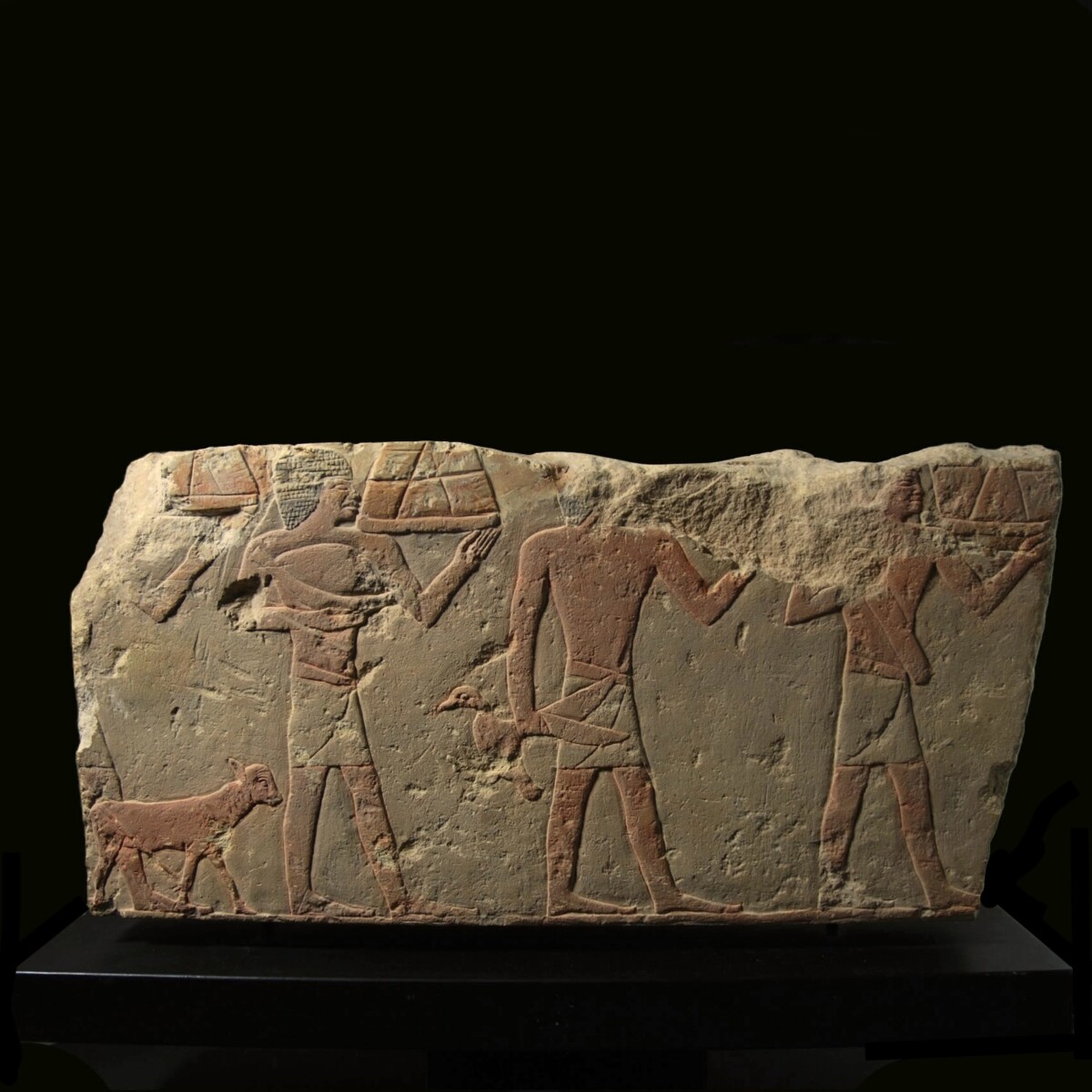
|
|
|
|
|
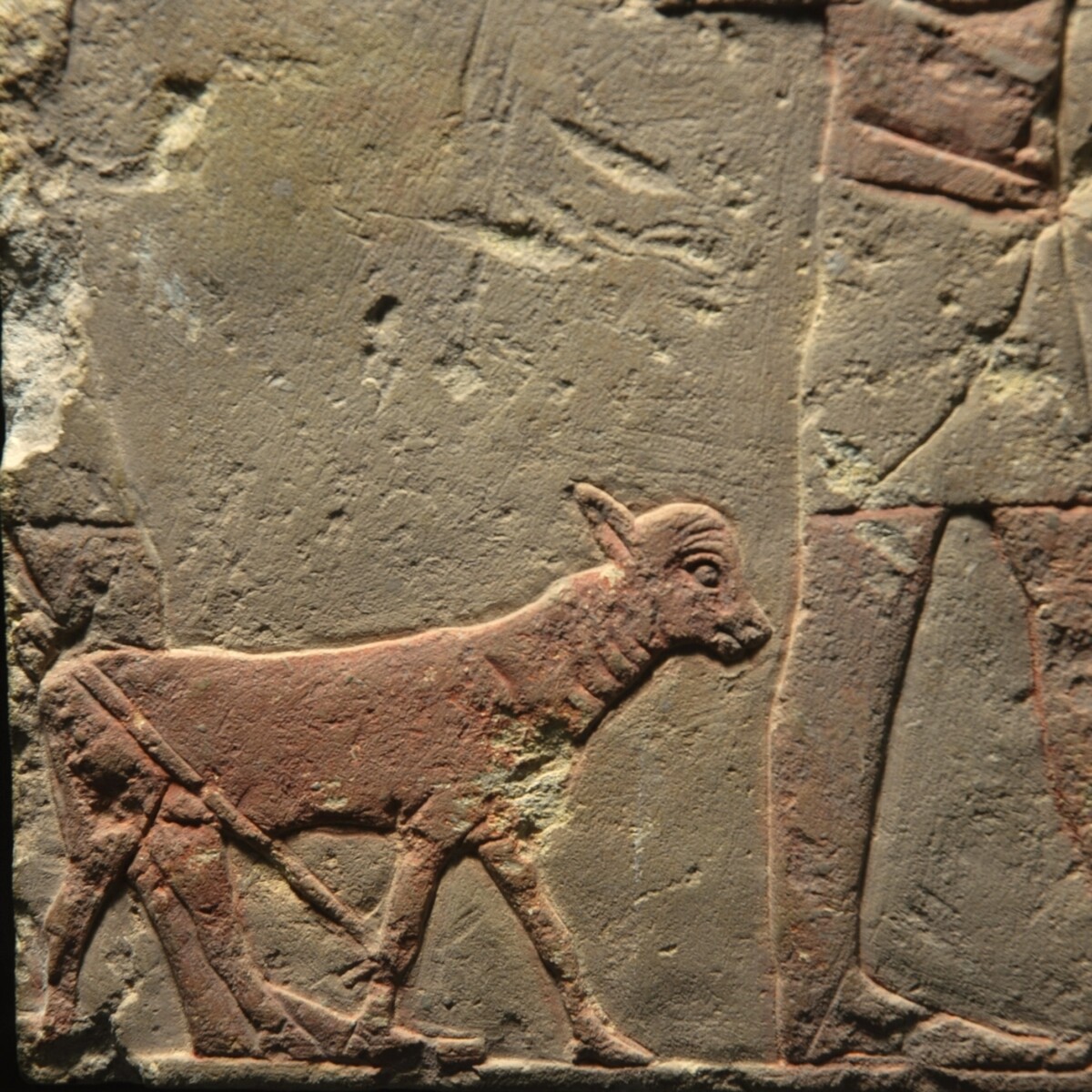
|
|
Egypt – Old Kingdom, 5th-6th dynasty, 2504-2216 B.C.
|
Important limestone relief with wonderfully preserved colors, which depicts a procession of offering bearers to the right. The men wear short white kilts, which cover their knees with vertical pleats in the front, as well as black wigs with small curls set in rows. Otherwise, they are without clothes, the skin color is painted in reddish brown. Preserved on the very left is the raised hand of an offering bearer, who carries a basket. In the other hand he holds a shepherd’s crook, which he uses to push a little calf. In front of him another servant walking with a basket, which he stems with the left hand and the left shoulder. He holds a large piece of ham in his right hand. The third offering bearer has the right arm lowered and grabs with his hand an agitated duck at its wings. The foremost servant balances with the left hand also a basket on his shoulder. In the right hand in front of the chest is the bottom of a bouquet recognizable, possibly of papyrus stems. Compare the depiction with the reliefs from the mastaba of the vizir Kagemni (ca. 2350 B.C.) from Saqqara and from the tomb of the high priest and boat driver Ny-ankh-Nesut, also from Saqqara, here especially the relief in the Allan Memorial Art Museum in Oberlin, Ohio, USA, with the object number 1943.302. Mounted on an old heavy metal base.
|
Provenance: Collection Robert Dubois, Brussels, Belgium, acquired in the 1970s. In 1988 by descent to Alain Dubois, Brussels. Thence in a family estate. With a confirmation by the heirs.
Dimensions: 19 cm x 38.4 cm
Price: 40 000 Euro
|
|
|
Ägypten – Altes Reich, 5.-6. Dynastie, 2504-2216 v. Chr.
|
Bedeutendes Kalksteinrelief mit wunderbar erhaltenen Farbresten, das eine Prozession von Gabenbringern nach rechts zeigt. Die Männer tragen kurze, weiße Schurze, die knapp über den Knien enden und vorne vertikale Falten bilden sowie schwarze Perücken mit in Zeilen gesetzten Löckchen. Abgesehen davon sind sie unbekleidet, der Hautton ist in rötlich brauner Farbe wiedergegeben. Ganz links ist die erhobene Hand eines Gabenbringers erhalten, der einen Korb trägt. In der anderen Hand hält er einen Hirtenstab, mit dem er ein kleines Kalb vor sich hertreibt. Vor ihm geht ein weiterer Diener mit einem Korb, den er mit der linken Hand und der linken Schulter stemmt. In seiner rechten Hand hält er ein großes Stück Schinken. Der dritte Gabenbringer hat den rechten Arm gesenkt und packt mit seiner Hand eine aufgeregt flatternde Ente an den Flügeln. Der vorderste Diener balanciert ebenfalls einen Korb mit der linken Hand auf seiner Schulter. In der vor der Brust gehaltenen rechten ist noch die Unterseite eines Straußes, wohl aus Papyrusstängeln, zu erkennen. Vergleiche zur Darstellung die Reliefs aus der Mastaba des Wesirs Kagemni (ca. 2350 v. Chr) aus Sakkara sowie aus dem Grab des Hohepriesters und Bootführers Ny-ankh-Nesut ebenfalls Sakkara, hier vor allem das Relief im Allan Memorial Art Museum in Oberlin, Ohio, USA, mit der Objektnummer 1943.302. Auf einem alten schweren Metallsockel montiert.
|
Provenienz: Sammlung Robert Dubois, Brüssel, Belgien, erworben in den 1970er Jahren. 1988 durch Erbe an Alain Dubois, Brüssel. Seitdem in Familienbesitz. Mit Bestätigung der Erben.
Dimensionen: 19 cm x 38,4 cm
Preis: 40.000 Euro
|
|
|
|
Selected Artworks of the Month:
|
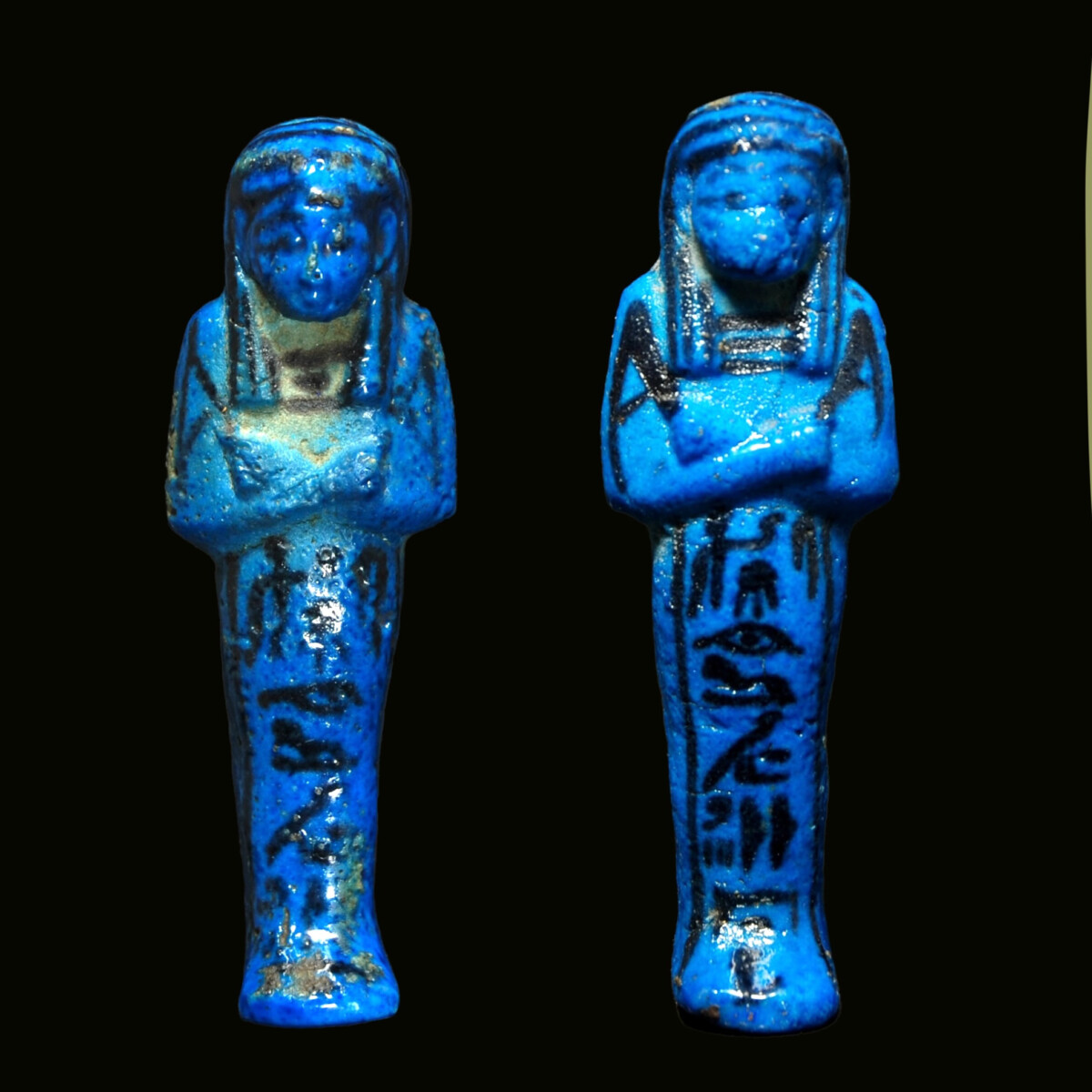
|
|
|
|
|

|
|
Egypt – 3rd Intermediate period, 21st dynasty, 1069-945 B.C.
|
Two finely worked out shabtis of blue glazed faience, which belonged to Tayu-heret and were found in 1881 in the famous cache at Deir el Bahri (“Royal Cache”). Tayu-heret was the wife of the Amun high priest Masaharta, one of the sons of the King of Upper Egypt Pinedjem I. She held the title “Chief of the harem of Amen-Re”. Today around 60 shabtis of Tayuheret are known, which are in museums and private collections. The present two examples originally belonged to the collection of the German archaeologist Emil Brugsch (1842-1930), who was significantly involved in the recovery of the mummies and art treasures from the cache at Deir el-Bahar. The shabtis are in mummiform with the arms crossed in front of the chests, each one holding a hoe. They wear tripartite wigs with horizontal stripes on the calotte and vertical ones on the lobes. Eyes, brows, collar and the seed bag on the back are painted in black, mouth and nose are protruding. The hieroglyphs run vertically along the front of the legs and mention the names of the owner. The translation reads: “May Osiris enlighten Tayu-heret.” For a standard work to the shabtis of Tayu-heret see Niek de Haan and Patrice Renaut “The workers shabtis of Tayu-heret”, First Edition 2022, published on shabticollections.com. At least 14 shabtis of Tayuheret are in the Egyptian Museum in Cairo, further ones in the Louvre (inventory number E 7677, E 20325), in the British Museum (inventory number 35371), and in the Kunsthistorisches Museum in Vienna (inventory number INV 6060), as well as in numerous other important museums in the USA and Europe. On an old wood base. One shabti with an old inventory number 36.3.31 at the back.
|
Provenance: Found 1881 in the cachette of Deir el-Bahari. Thence in the collection of the archaeologist Emil Brugsch (1842-1930), who played a key role in recovering the finds. Later with Christie’s Tokyo on 11 February 1980, lots 655 and 656. Last in the Dr. W. Benson Harer family collection. With a copy of the collection note.
Dimensions: 10.6 cm and 10.8 cm high respectively
Price: 18 000 Euro
|
|
|
Ägypten – 3. Zwischenzeit, 21. Dynastie, 1069-945 v. Chr.
|
Zwei fein gearbeitete Uschebtis aus blau glasierter Fayence, die zur Grabausstattung der Taiu-heret gehörten und 1881 in der berühmten Cachette von Deir el-Bahari („Royal Cache“) gefunden wurden. Taiu-heret war die Frau des Amun-Hohepriesters Masaharta, eines Sohnes des Königs von Oberägypten Pinudjem I. Sie trug den Titel „Aufseherin des Harems des Amun-Re“. Heute sind rund 60 Uschebtis der Taiu-heret bekannt, die sich in Museen und Privatsammlungen befinden. Unsere beiden Exemplare stammen ursprünglich aus der Sammlung des deutschen Archäologen Emil Brugsch (1842-1930), der maßgeblich an der Bergung der Funde aus der Cachette von Deir el-Bahari beteiligt war. Die mumienförmigen Uschebtis haben über der Brust gekreuzte Arme, die jeweils eine Hacke halten. Sie tragen eine dreiteilige Perücke mit horizontalen Streifen auf der Kalotte und vertikalen an den Lappen. Augen, Brauen, Halsschmuck und das Saatgutsäckchen am Rücken sind in schwarz aufgemalt, Mund und Nase treten plastisch hervor. Die Hieroglyphen verlaufen vertikal entlang der Vorderseite der Beine und nennen den Namen der Besitzerin. Die Übersetzung lautet: „Möge Osiris Taiu-heret erleuchten.“ Eine grundlegende Arbeit zu den Uschebtis der Taiu-heret siehe Niek de Haan und Patrice Renaut „The workers shabtis of Tayu-heret“, First Edition 2022, publiziert auf shabticollections.com. Mindestens 14 Uschebtis der Taiu-heret befinden sich im Ägyptischen Museum in Kairo, weitere im Louvre (Inventarnummer E 7677, E 20325), im British Museum (Inventarnummer 35371), im KHM in Wien (Inventarnummer INV 6060) sowie in zahlreichen weiteren bedeutenden Museen in den USA und Europa. Auf altem Holzsockel. Ein Uschebti mit alter Inventarnummer 36.3.31 auf der Rückseite.
|
Provenienz: Gefunden 1881 in der Cachette von Deir el-Bahari. Danach in der Sammlung des Archäologen Emil Brugsch (1842-1930), der an der Bergung der Funde maßgeblich beteiligt war. Später bei Christie’s Tokio am 11. Februar 1980, Lose 655 und 656. Zuletzt in der Dr. W. Benson Harer Familiensammlung. Mit Kopien der Sammlungsnotizen.
Höhe: 10,6 cm bzw., 10,8 cm
Preis: 18.000 Euro
|
|
|
|
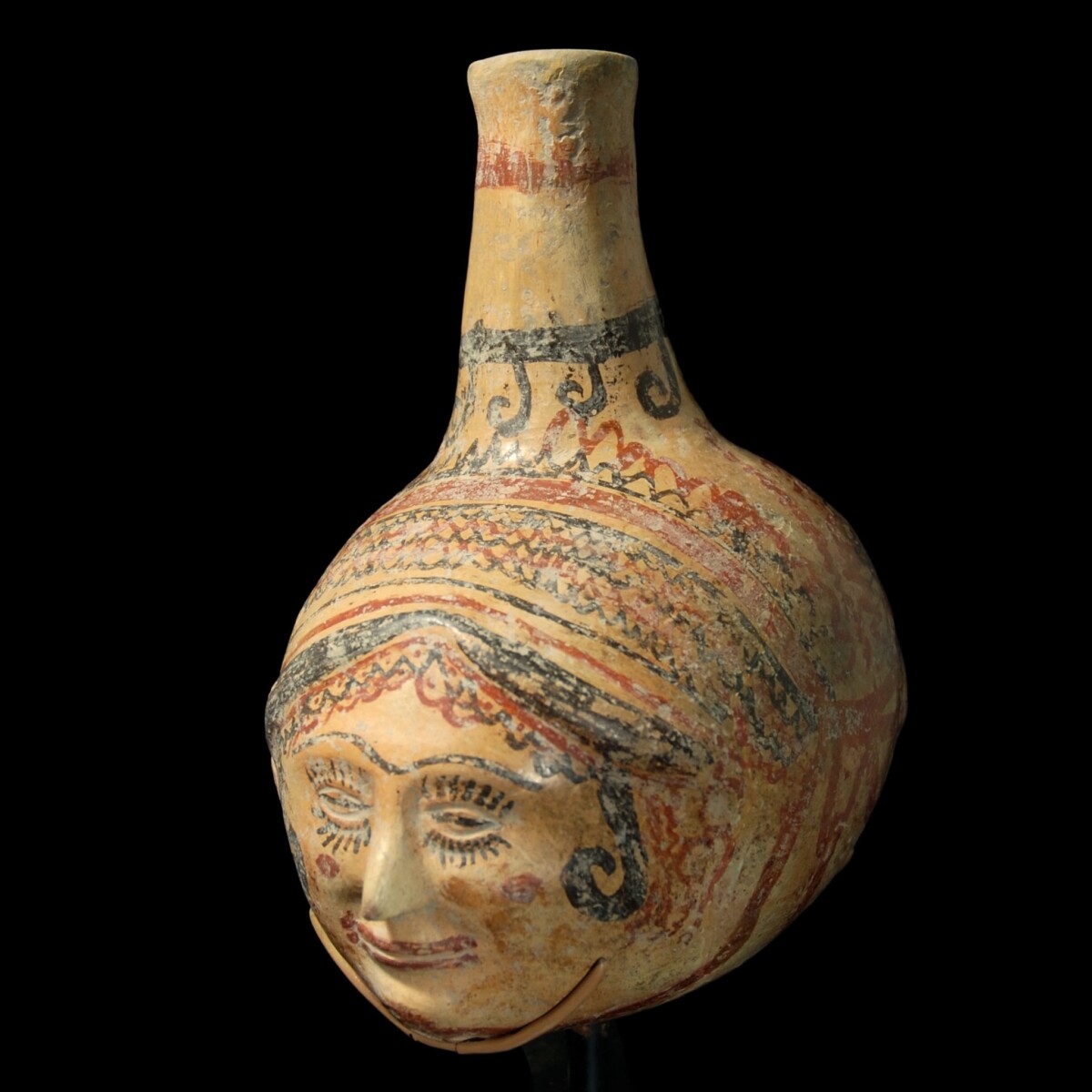
|
|
|
|
|
|
Greece/Phrygia – 6th century B.C.
|
Finely painted Eastern Greek terracotta rhyton with janus-shaped, sculptural women’s faces on both sides. The faces with long lashes, small eyes under curved brows and an archaically smiling mouth with red lips. The women wear a veil that is also sculptural, underneath protruding red and black curls. On the sides along the face a thick, black strand of hair curled inwards cascades over the temples. Behind them sculptural ears with round, red earrings. On the chin a round opening on both sides where the libation ran through. The entire vessel is painted with red and black color. Wavy lines, which can also be interpreted as a hair net, alternate with broad bands. On the sides thick red garlands are painted. On the steeply rising, cylindrical pouring hole black curls hang down from the encircling band. The rare libation vessel possibly originates from east Phrygia. A vessel fragment with very similar women’s faces, which was found in the east Anatolian city of Patnos, is today in the Archaeological Museum in Ankara with the inventory number 8823. It is published in the museum catalogue of the exhibition “Art Treasures from Turkey”, Washington 1966, page 83, no. 88 (with illustration). The exhibition toured from 1966 to 1968 in numerous US museums and was organised by the Smithsonian Institute. A rare rhyton with excellently preserved colors. Mounted.
|
Provenance: From the Belgian collection Frances Artuner, acquired in the 1960s. Thence in a New York collection. Auctioned with Artemis Gallery on 21 February 2019, lot 20A. Thence in the New York art market.
Dimensions: 20.2 cm x 18.8 cm
|
|
|
Griechenland/Phrygien – 6. Jahrhundert v. Chr.
|
Fein bemaltes ostgriechisches Terrakotta-Rhyton mit janusförmigen, plastischen Gesichtern von Frauen an beiden Seiten. Die Gesichter mit langen Wimpern, schmalen Augen unter gewölbten Brauen und einem archaisch lächelnden Mund mit roten Lippen. Die Frauen tragen einen ebenfalls plastischen ausgearbeiteten Schleier, unter dem rote und schwarze Haarlocken hervorschauen. Seitlich fällt den Gesichtern jeweils eine nach innen eingerollte, dicke schwarze Haarsträhne über die Schläfen. Dahinter sind plastische Ohren, von denen runde, rote Ohrringe herabhängen. Am Kinn ist auf beiden Seiten eine runde Öffnung, über die die Libationsflüssigkeit ausgeschüttet wurde. Das gesamte Gefäß ist mit roter und schwarzer Farbe bemalt. Wellenlinien, die auch als Haarnetz gedeutet werden können, wechseln sich dabei mit breiten Bändern ab. An den Seiten sind dicke rote Girlanden aufgemalt. Am steil aufragenden, zylindrischen Einfüllloch hängen schwarze Locken von einem umlaufenden Band herab. Das seltene Libationsgefäß stammt wohl aus dem östlichen Phrygien. Ein Gefäßfragment mit sehr ähnlichen Frauengesichtern, das in der ostanatolischen Stadt Patnos gefunden wurde, befindet sich im archäologischen Museum in Ankara mit der Inventarnummer 8823. Publiziert ist es im Museumskatalog der Ausstellung „Art Treasures from Turkey“, Washington 1966, auf Seite 83, Nr. 88 (mit Abbildung). Die Ausstellung gastierte in den Jahren 1966-1968 in zahlreichen US-Museen und wurde vom Smithsonian Institute organisiert. Ein seltenes Rhyton mit hervorragend erhaltenen Farben. Gesockelt.
|
Provenienz: Aus der belgischen Sammlung Frances Artuner, erworben in den 1960er Jahren. Danach in einer New Yorker Sammlung. Versteigert bei Artemis Gallery am 21. Februar 2019, Los 20A. Danach im New Yorker Kunsthandel.
Dimensionen: 20,2 cm x 18,8 cm
Preis: 8.000 Euro
|
|
|
|
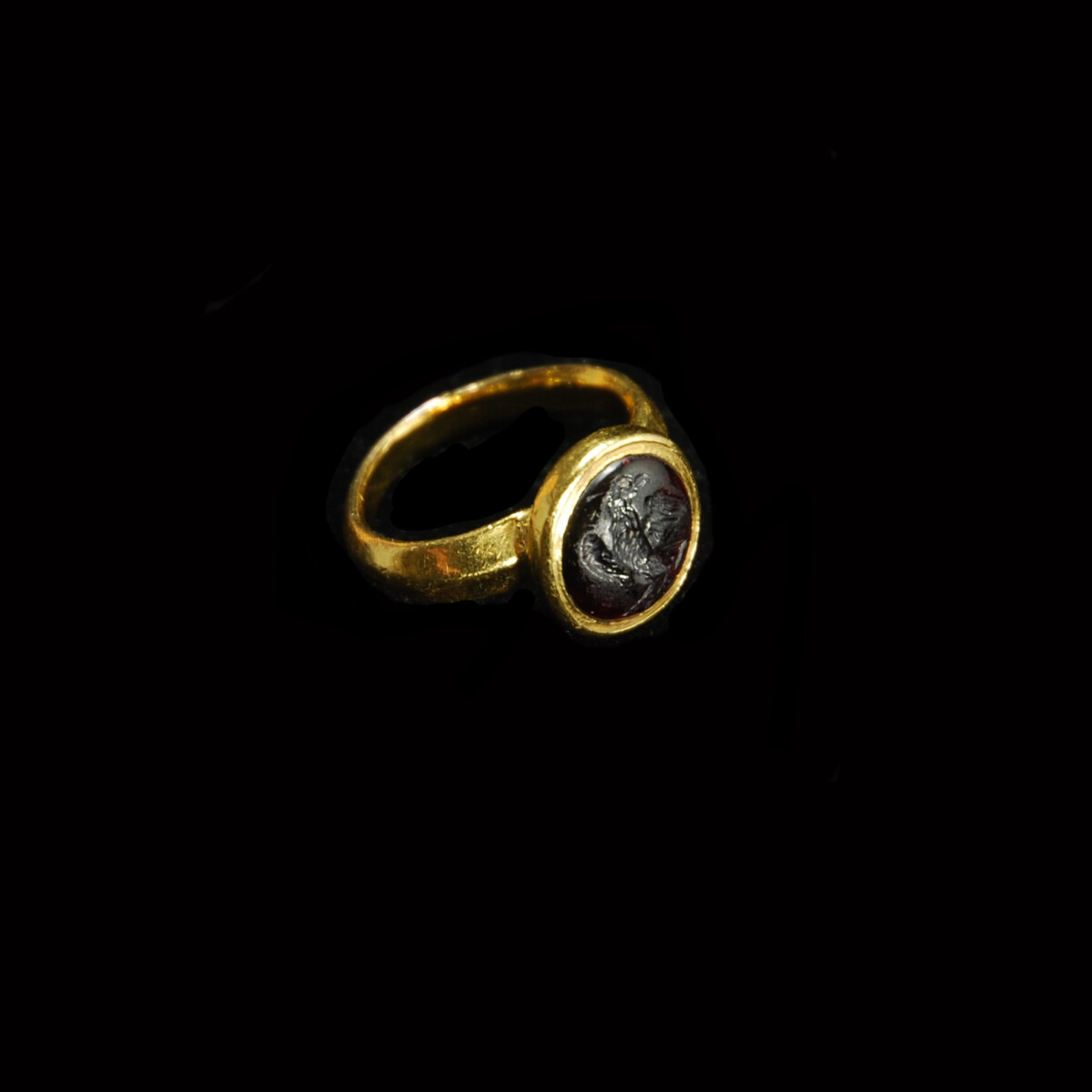
|
|
|
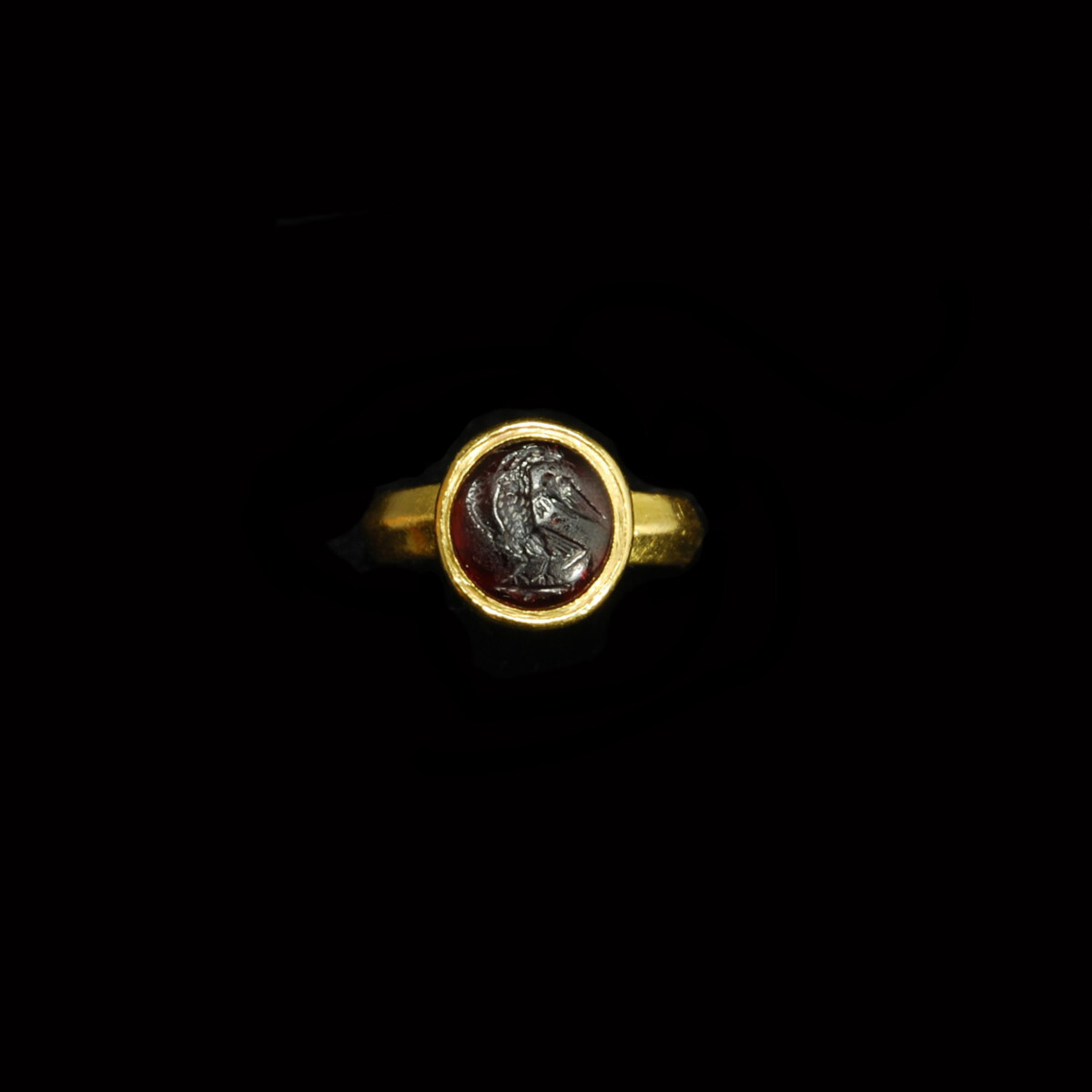
|
|
Roman Empire – 1st century B.C.
|
Magnificently preserved gold ring of type XIV of the classic finger rings according to Boardman (John Boardman "Greek Gems and Finger Rings", Thames & Hudson Ltd., London 2001). The hoop - inside flat, outside rounded with a gentle, central bend - ends in a massive, round and deep bezel, which is framed by two encircling bands. Therein sits a garnet intaglio, clearly rising above the bezel and cut with an eagle on a plinth with open wings. The eagle with a long, strong beak with its head turned to the right. Fine details in the plumage and claws. A beautiful, ready-to-wear ring size.
|
Provenance: Galerie Nefer, Switzerland. In 1976 sold to a US private collection. Thence in a family estate until 2021. Last in the collection Maximilian Eisl, Vienna, Austria.
Dimensions: 2.5 cm (ring height); 2 cm in diameter; 10 gram
Price: 6 600 Euro
|
|
|
Römisches Reich – 1. Jahrhundert v. Chr.
|
Prachtvoll erhaltener Goldring des Typs XIV der klassischen Fingerringe nach Boardman (John Boardman "Greek Gems and Finger Rings", Thames & Hudson Ltd., London 2001). Die Schiene – innen flach, außen mit sanftem, mittigem Knick abgerundet – endet in einer massiven runden und tiefen Fassung, die von zwei umlaufenden Bändern begrenzt ist. Darin sitzt eine deutlich über die Fassung hinaus ragende, abgerundete Gemme aus Granat, in die ein auf einer Plinthe stehender Adler mit ausgebreiteten Flügeln geschnitten ist. Der Adler mit langem, starkem Schnabel hat den Kopf nach rechts gerichtet. Feine Details im Gefieder und an den Krallen. Eine schöne tragbare Größe.
|
Provenienz: Galerie Nefer, Schweiz. 1976 an eine amerikanische Privatsammlung verkauft. Danach in Familienbesitz bis 2021. Zuletzt in der Sammlung Maximilan Eisl, Wien.
Dimensionen: Ringhöhe 2,5 cm; Durchmesser 2 cm; Gewicht 10 Gramm
Preis: 6.600 Euro
|
|
|
|
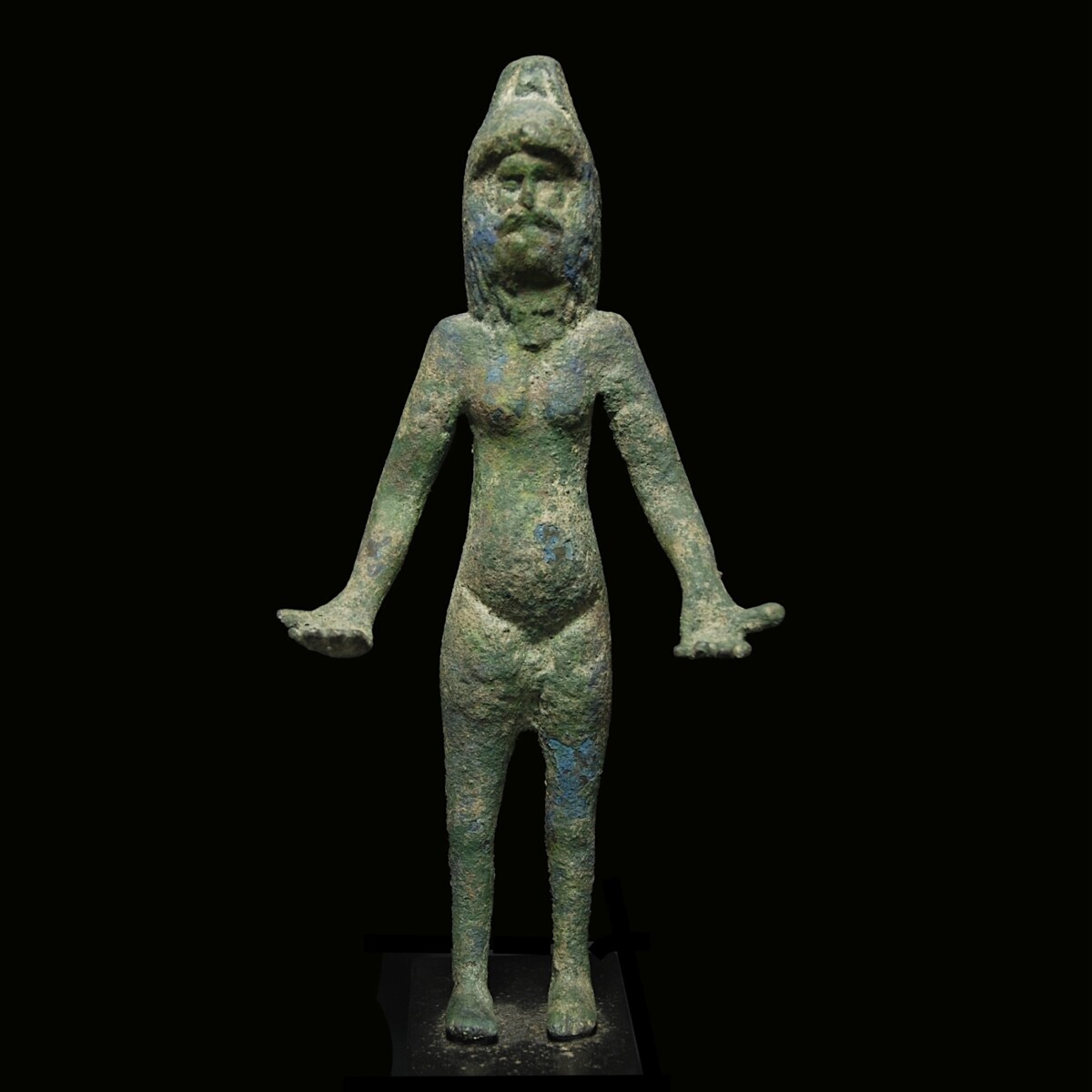
|
|
|
|
|
|
Etruria – Late 6th to early 5th century B.C.
|
Large and solid worked out bronze statuette of a woman with a theater mask. The actress without clothes has a little belly, small round breasts and stands upright with slightly spread legs. She holds her arms forward with the palms facing up. Perforations in the hands indicate that she either held a separately worked out object or another person. Striking is the theater mask of a bearded man, possibly Poseidon, which she holds in front of her face and is crowned by a high headdress. The back of the head of the actress is free and exposes her elaborate, braided hair with thick strands. A very rare, archaic work from Etruria. On a high metal base.
|
Provenance: New York private collection S. Rey, acquired prior to 1956. On 8 May 1956 acquired from the gallery Ernest Brummer (1891-1964), Paris and New York. With a copy of the inventory list, as well as an old exhibition picture. Thence by descent to the widow Ella Bache Brummer until 1999, as well as by succession to the nephew Dr. John Laszlo, Atlanta, Georgia.
Dimensions: 20.3 cm high; 27.9 cm high (including base)
Price: 8 000 Euro
|
|
|
Etrurien – Ende 6. bis Anfang 5. Jahrhundert v. Chr.
|
Große und massiv gearbeitete Bronze-Statuette einer Frau, die eine Theatermaske trägt. Die unbekleidete Schauspielerin hat einen leichten Wamst, kleine runde Brüste und steht aufrecht mit leicht gespreizten Beinen. Die Arme hält sie mit den Handflächen nach oben nach vorne. Lochungen in den Händen weisen darauf hin, dass sie ein separat gearbeitetes Objekt oder eine weitere Person in den Händen hielt. Auffällig ist die Theatermaske eines bärtigen Mannes, möglichwerweise Poseidon, die sie vor ihrem Gesicht trägt und die von einem hohen Kopfschmuck bekrönt wird. Der Hinterkopf der Schaupielerin liegt frei und zeigt ihre aufwendig, mit dicken Strähnen geflochtene Frisur. Eine überaus seltene, archaische Arbeit aus Etrurien. Auf hohem Metallsockel.
|
Provenienz: New Yorker Privatsammlung S. Rey, erworben vor 1956. Am 8. Mai 1956 erworben von der Galerie von Ernest Brummer (1891-1964), Paris und New York. Mit Kopie der Inventarliste sowie einem alten Ausstellungsfoto. Danach durch Erbe an die Witwe Ella Bache Brummer bis 1999 sowie in Erbfolge an den Neffen Dr. John Laszlo, Atlanta, Georgia.
Höhe: 20,3 cm; Höhe mit Stand: 27,9 cm
Preis: 8.000 Euro
|
|
|
|
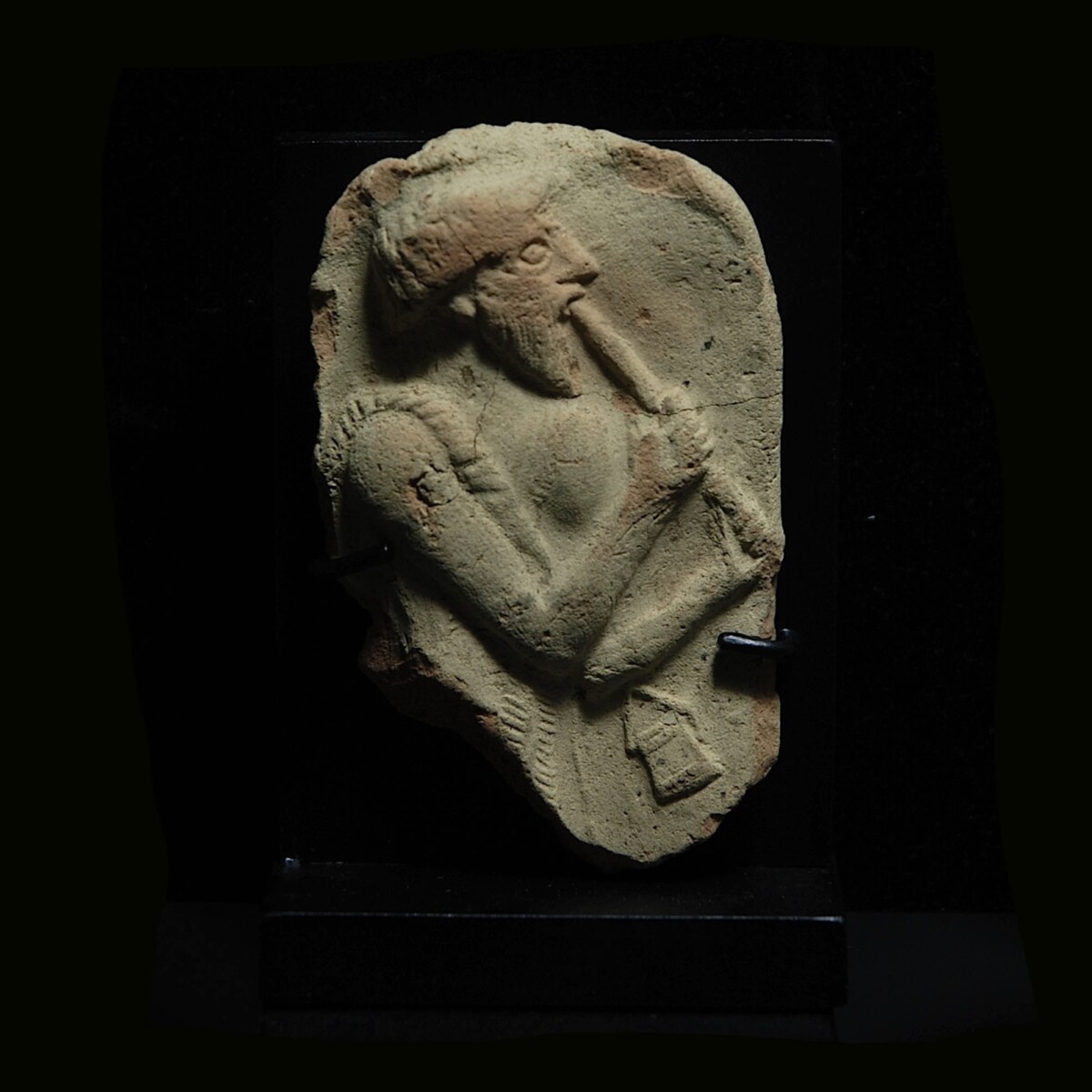
|
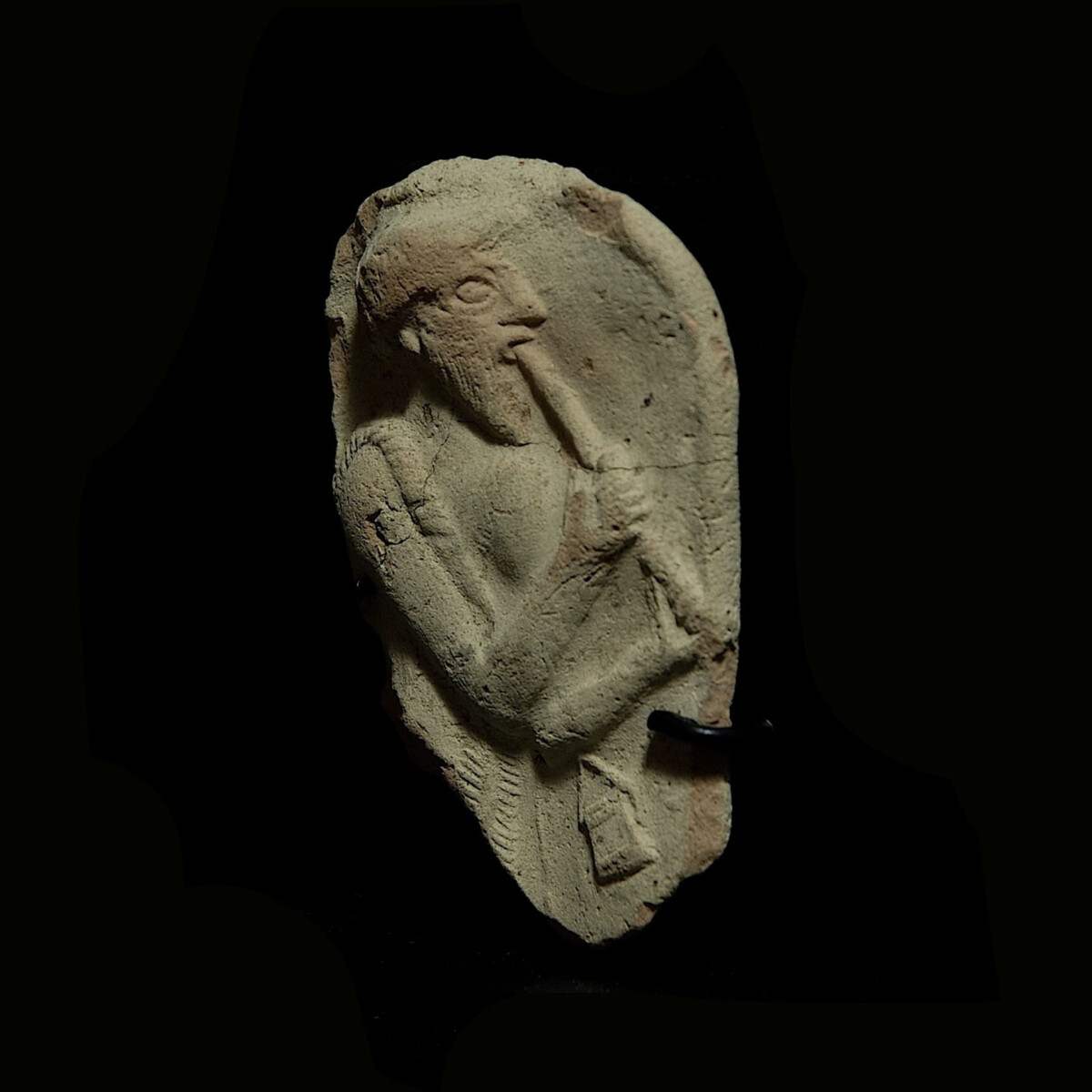
|
|
|
|
Mesopotamia – 2000-1800 B.C.
|
Rare clay plaque depicting a bearded man with large eyes who plays a flute made of reeds. He is a shepherd. He wears a formfitting cap and has a small bag tied around his shoulders. The flute, a forerunner of the “Shabbaba” that is still widespread in the Arab world today, has been known since the 3rd millennium BC. It was often played during funerals. Shepherds, such as the one on the present votive plaque, also played for their own entertainment and distraction in front of their animals. One of the oldest depictions of a flute player is on a Sumerian shell ornament from Nippur and dates to the period from 2600 to 2500 B.C. Also known are numerous depictions on cylinder seals. However, on clay plaques the depiction is relatively rare. With numerous fingerprints of the artist on the back. Mounted.
|
Provenance: From the collection of the Israeli judge Steve Adler, Jerusalem.
Dimensions: 8.1 cm high
Price: 1 200 Euro
|
|
|
Mesopotamien – 2000-1800 v. Chr.
|
Seltene Tonplakette, die einen bärtigen Mann mit großen Augen zeigt, der eine Längsflöte, wohl aus Schilfrohren spielt. Es handelt sich um einen Hirten. Er trägt eine anliegende Kappe und hat ein Täschchen um die Schulter gebunden. Die Längsflöte, ein Vorläufer der heute in der arabischen Welt noch weit verbreiteten „Schabbaba“, ist seit dem 3. Jahrtausend vor Christus bekannt. Sie wurde häufig bei Begräbnissen gespielt. Hirten, wie auf dieser Votivplakette, spielten aber auch zur eigenen Unterhaltung und Ablenkung vor ihren Tieren. Eine der ältesten Darstellungen eines Flötenspielers befindet sich auf einem sumerischen Muschelornament aus Nippur und datiert in die Zeit von 2600-2500 v. Chr. Auch auf Rollsiegeln sind zahlreiche Abbildungen bekannt. Auf Tonplaketten ist die Darstellung hingegen vergleichsweise selten. Mit zahlreichen Fingerabdrücken des Künstlers auf der Rückseite. Gesockelt.
|
Provenienz: Aus der Sammlung des israelischen Richters Steve Adler, Jerusalem.
Höhe: 8,1 cm
Preis: 1.200 Euro
|
|
|
|
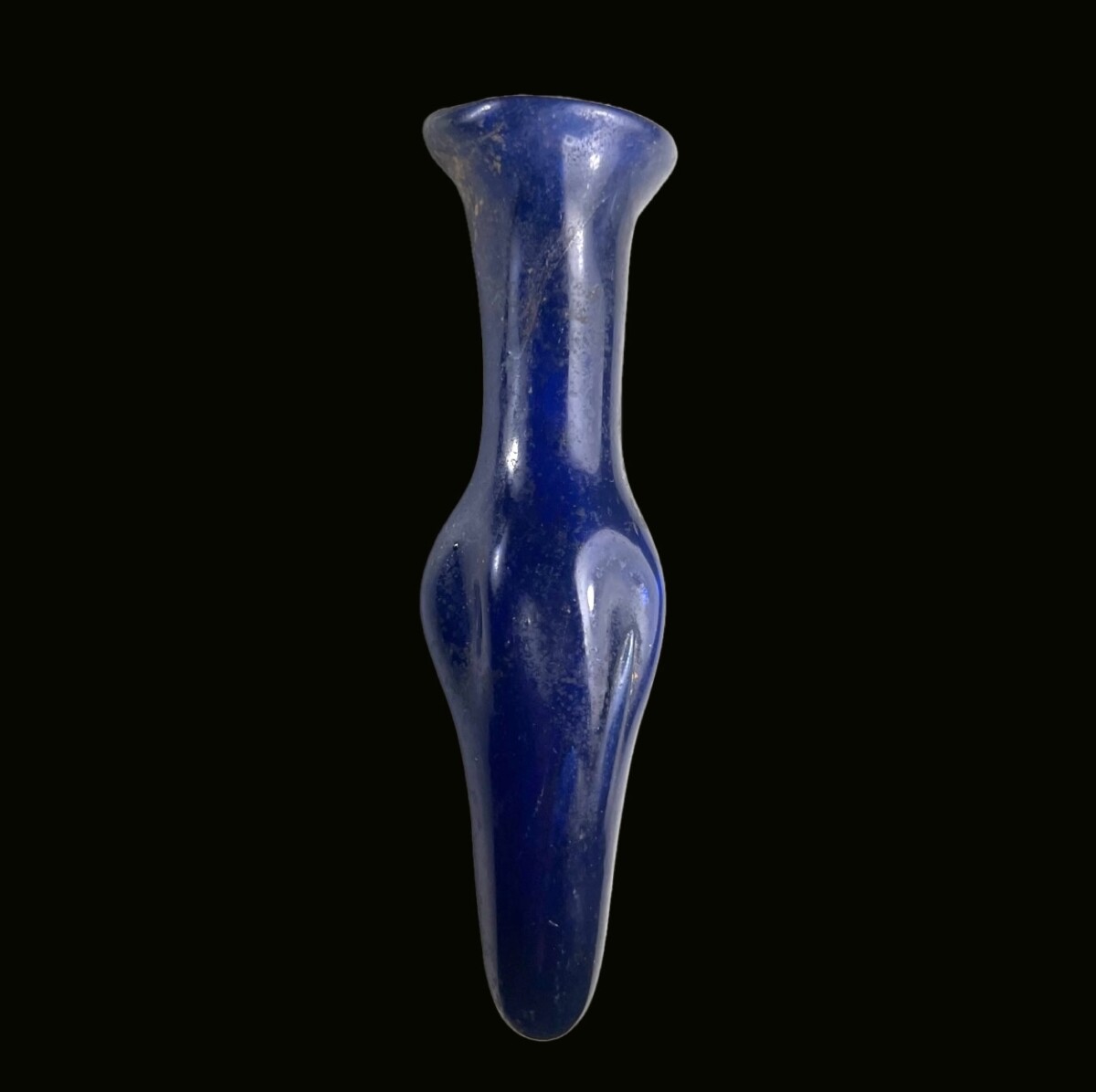
|
|
Roman Empire – 3rd century A.D.
|
Rare fusiform cobalt glass with an intensive dark blue color. The perfume flask with a far protruding, uneven rim, which is slightly folded inwards. The neck is long and cylindrical. The biconical corpus with six elegant indentations. The base is cone-shaped and rounded. The spindle-shaped flask belongs to the so-called compact type. Mounted.
|
Provenance: Private collection Arieh Klein, Jerusalem, Israel. Thence in the Israeli art market.
Dimensions: 11 cm high
Price: 2 200 Euro
|
|
|
Römisches Reich – 3. Jahrhundert n. Chr.
|
Seltenes spindelförmiges Kobaltglas mit intensiv dunkelblauer Färbung. Das Parfumfläschchen mit weit auskragendem, unebenem Rand, der leicht nach innen gefaltet ist. Der Hals ist lang und zylindrisch. Der bikonische Korpus mit sechs eleganten Vertiefungen. Der Boden ist zapfenförmig und verrundet. Die Spindelformflasche gehört der sogenannten Kompaktvariante an. Gesockelt.
|
Provenienz: Privatsammlung Arieh Klein, Jerusalem. Danach im israelischen Kunsthandel.
Höhe: 11 cm
Preis: 2.200 Euro
|
|
|
|
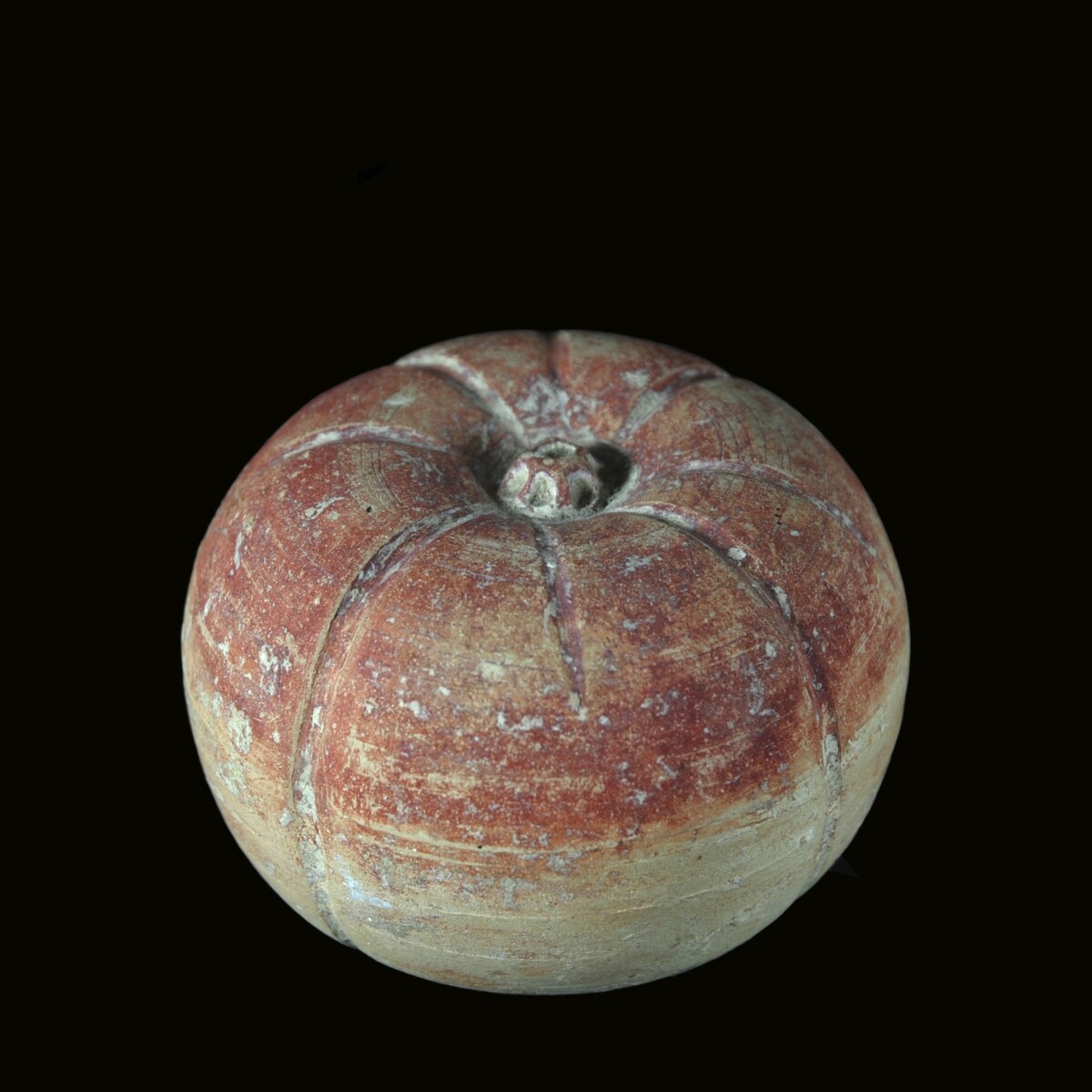
|
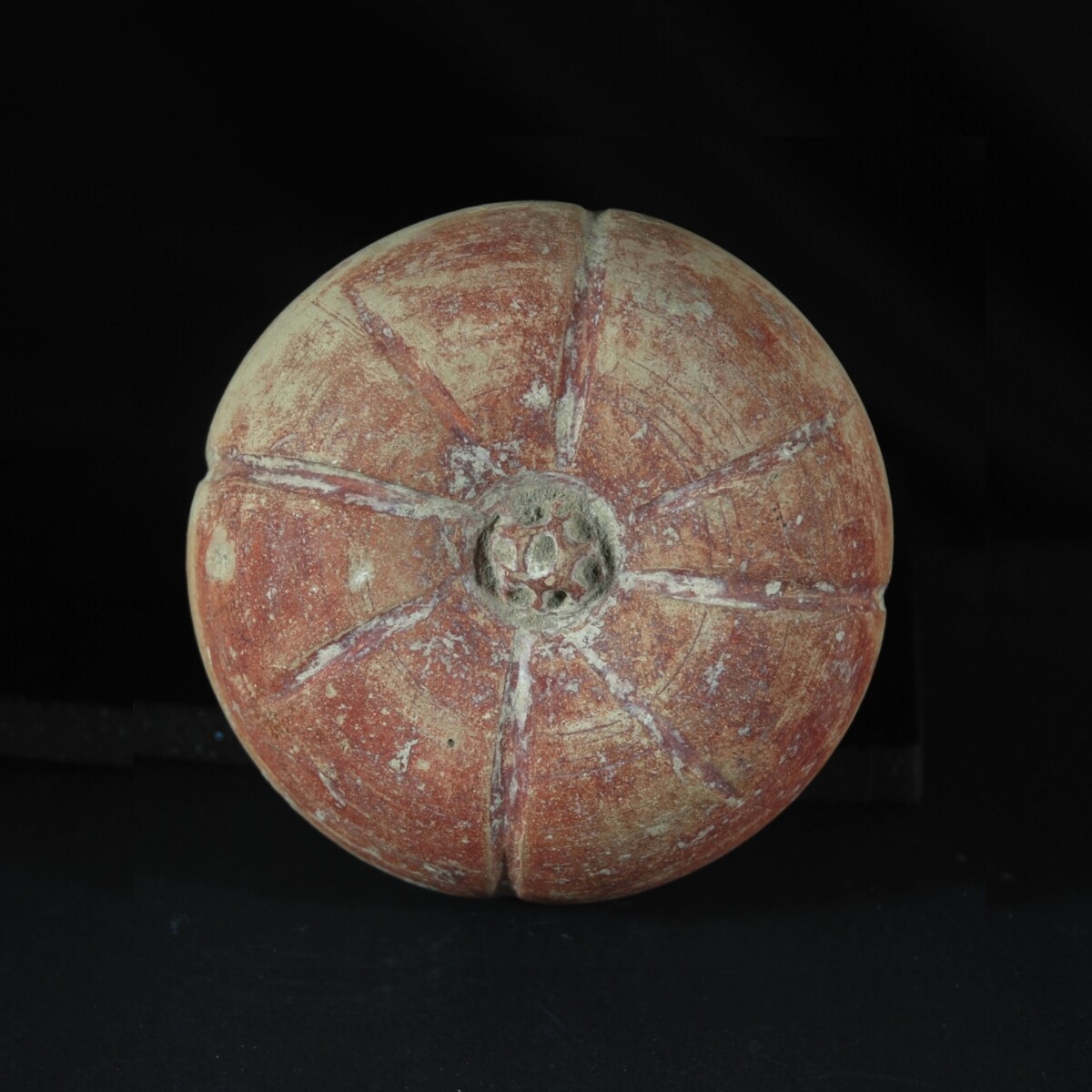
|
|
Greece – 5th-4th century B.C.
|
Large, hollow terracotta votive in form of a pomegranate with beautifully preserved colors. The fruit is divided by four long and four short indentations into sectors of almost the same size. The upper part in red color. In the centre is a short inflorescence finely accentuated. At the bottom is a hole for attaching the fruit - possibly in a terracotta fruit basket, such as the ones found in Rhodes. See for a terracotta fruit basket from Rhodes in the British Museum with the registration number 1864,1007.11. The pomegranate could also have belonged to a terracotta statue of Persephone, whose fate was to spend half of the year in the underworld, after having nibbled on pomegranates seeds. In any event, depictions of pomegranates were popular as votive- and funerary offerings in the entire Greek art from the Classic to the Hellenistic period, as the fruit stands for life, fertility and rebirth.
|
Provenance: From an old Swiss private collection. With a copy of an inventory list from the 1970s.
Dimensions: 8 cm high
Price: 1 600 Euro
|
|
|
Griechenland – 5.-4. Jahrhundert v. Chr.
|
Großes, hohl gearbeitetes Terrakotta-Votiv in Form eines Granatapfels mit schön erhaltenen Farben. Die Frucht ist durch vier lange und vier kurze Vertiefungen in acht etwa gleich große Sektoren unterteilt. Der obere Bereich mit roter Farbe. In der Mitte ist ein kurzer Blütenstand fein akzentuiert. An der Unterseite ist ein Loch zur Befestigung der Frucht – vielleicht in einem Terrakotta-Obstkorb wie man sie etwa auf Rhodos fand. Vergleiche dazu den Terrakotta-Obstkorb im British Museum mit der Registration Number 1864,1007.11. Der Granatapfel könnte aber auch zu einer Terrakotta-Statue der Persephone gehört haben, die das Schicksal hatte, jedes halbe Jahr in der Unterwelt zu verbringen, nachdem sie Granatapfelkerne genascht hatte. In jedem Fall waren Nachbildungen von Granatäpfeln in der gesamten griechischen Kunst von der Klassik bis in den Hellenismus beliebte Votiv- und Grabbeigaben, stand die Frucht doch für Leben, Fruchtbarkeit und Wiedergeburt.
|
Provenienz: Aus alter Schweizer Privatsammlung. Mit der Kopie einer Inventarliste aus den 1970er Jahren.
Durchmesser: 10,5 cm; Höhe: 8 cm
Preis: 1.600 Euro
|
|
|
|
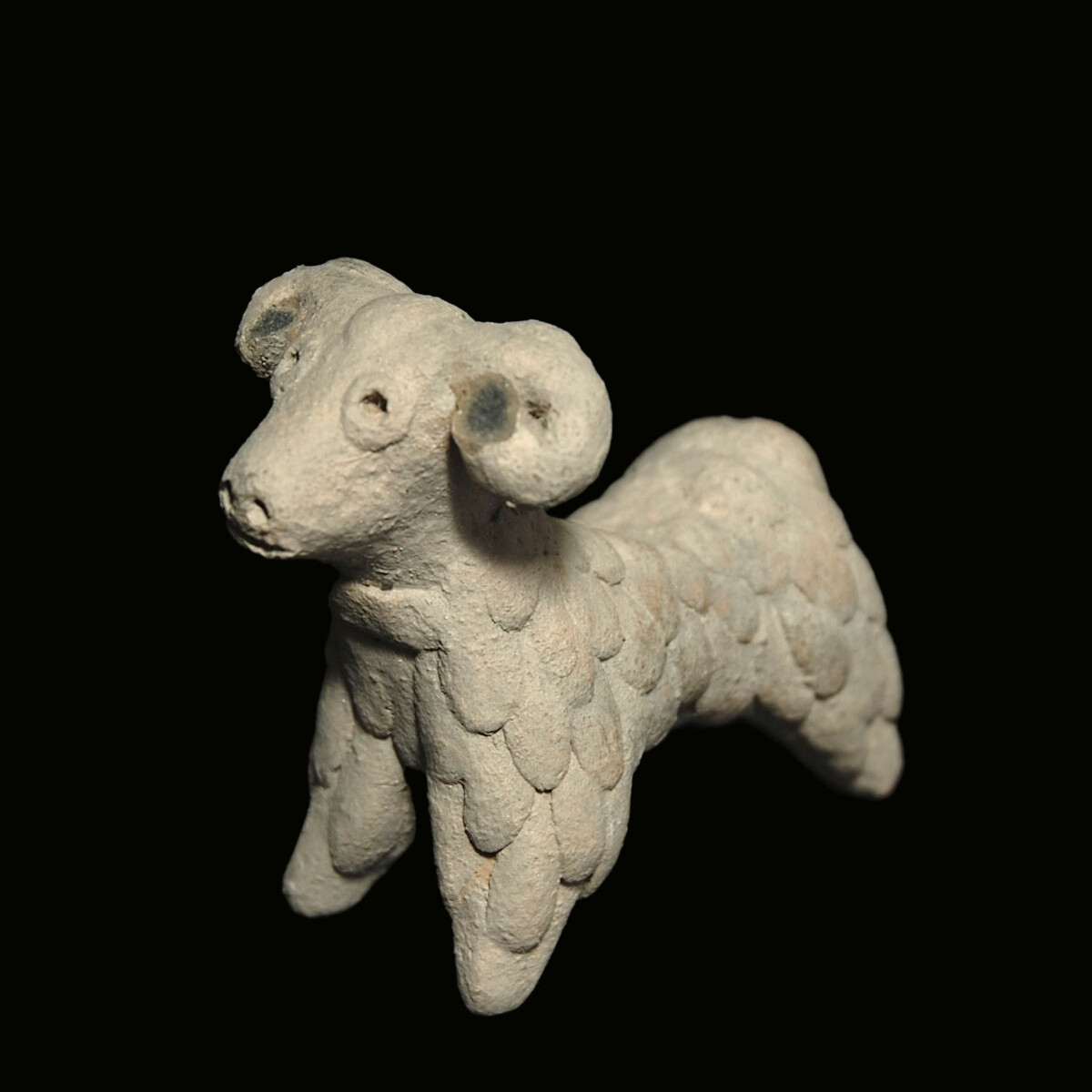
|
|
|
|
|
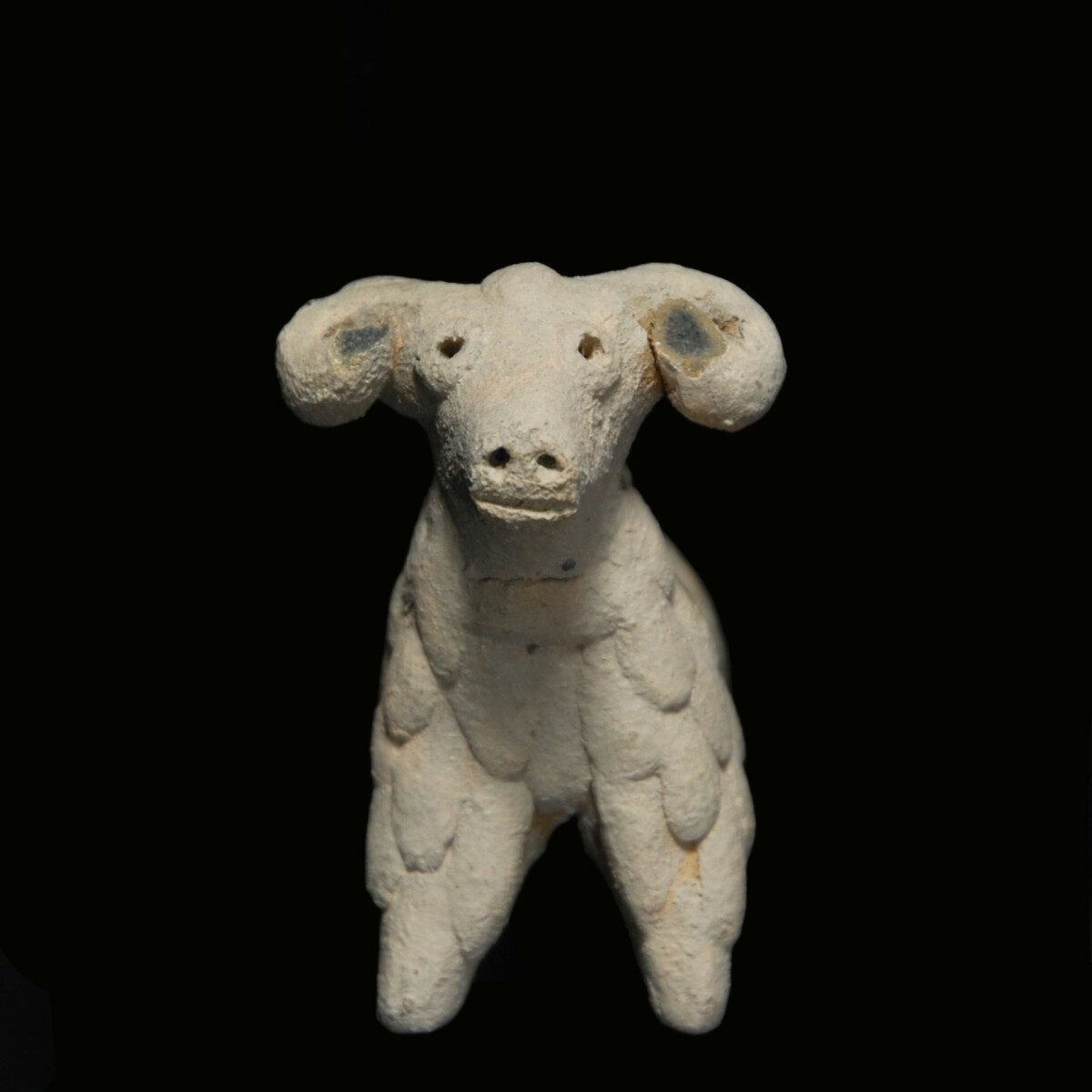
|
|
Levant – 1st half of 2nd millennium B.C.
|
Hand formed, Syro Hittite terracotta figure of a ram. The animal has its head raised and looks straight forward with deeply pierced circular eyes. The curled horns are facing forward . On the snout pierced nostrils. The body stands on short, straight legs and is completely covered with thick woolly hair, except for the smooth bottom. An exceedingly charming statuette. See for the typus Bonham’s auction London of 13 October 2006, lot 329.
|
Provenance: Private collection Dr. Peter Rudeck, Vienna, Austria. Acquired on 15 November 1993 from Gerhard Herinek in Vienna. With the original certificate.
Dimensions: 7.9 cm high
Price: 800 Euro
|
|
|
Levante – 1. Hälfte 2. Jahrtausend v. Chr.
|
Handgeformte, syro-hethitische Terrakotta-Figur eines Widders. Das Tier hat den Kopf angehoben und blickt aus tief gelochten Kreisaugen geradeaus. Die eingerollten Hörner sind nach vorne gerichtet. An der Schnauze gelochte Nüstern. Der Körper steht auf kurzen, geraden Beinen und ist bis auf die glatte Unterseite komplett mit dicken Wollzotten bedeckt. Eine äußerst reizvolle Statuette. Vergleiche zum Typus Bonhams Auktion London vom 13. Oktober 2006, Los 329.
|
Provenienz: Privatsammlung Dr. Peter Rudeck, Wien. Erworben am 15. November 1993 bei Gerhard Herinek in Wien. Mit Original-Zertifikat.
Höhe: 7,9 cm
Preis: 800 Euro
|
|
|
|
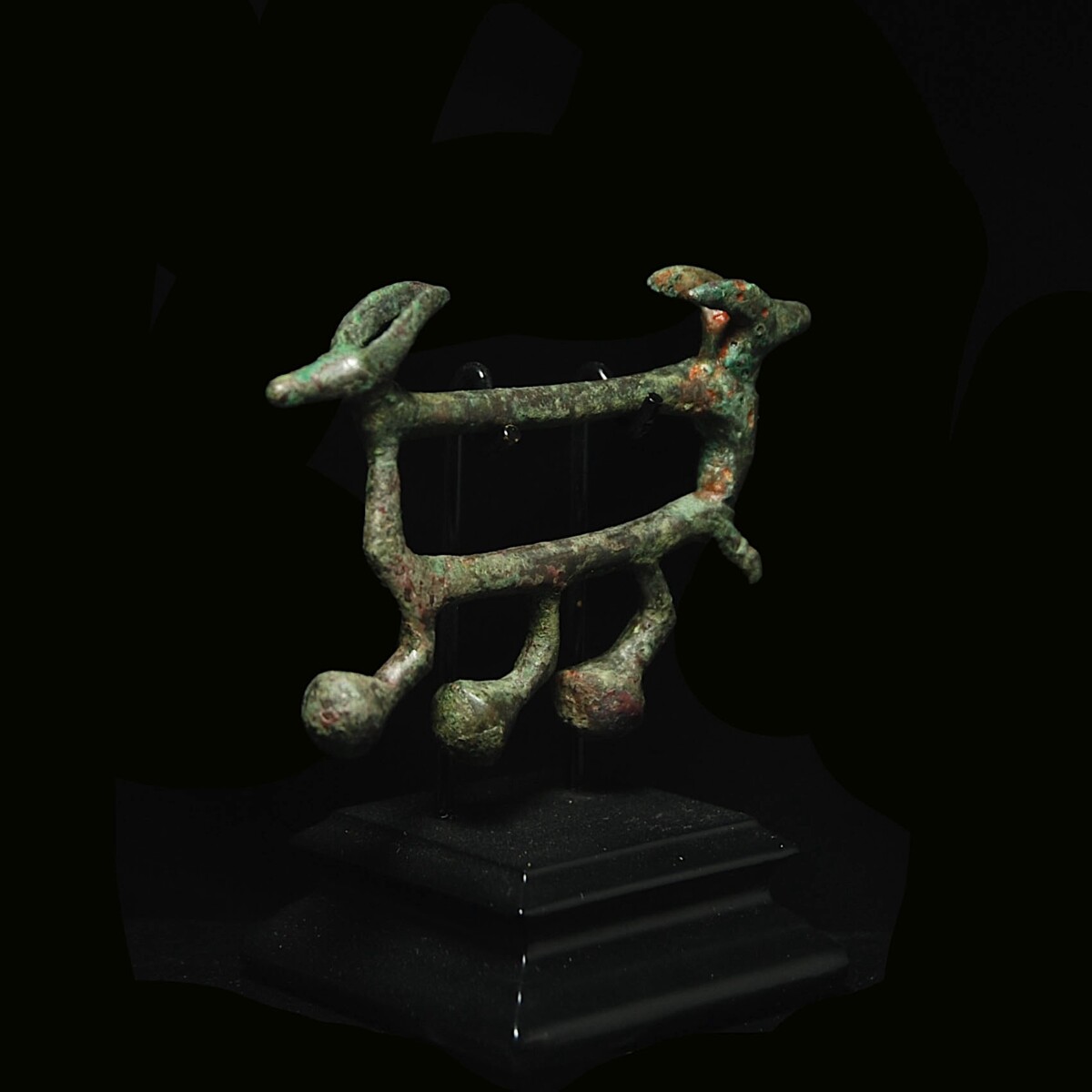
|
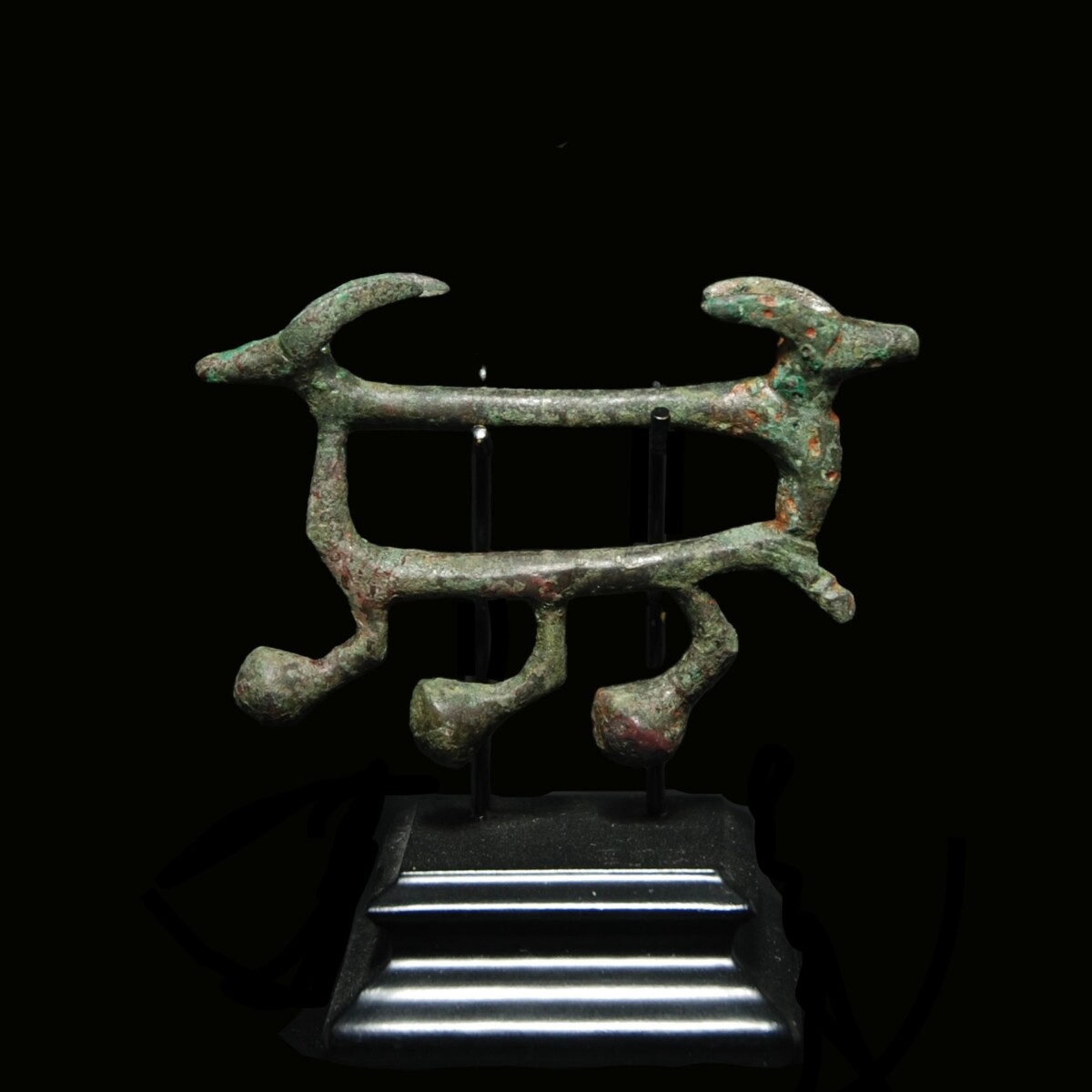
|
|
Iran/Luristan – around 900 B.C.
|
Bronze buckle, possibly from a belt with two opposite ibexes on both ends. The stylized heads of the horned animals are connected by two round bronze links. On the lower connecting link there are three bent and onion-headed hooks at the end with which the belt was once closed. Holes through the neck of the ibexes for hanging the buckle on the belt. On a beautiful, profiled wood base.
|
Provenance: Private collection Monaco, acquired in the German art market between 1990 and 2000.
Dimensions: 7.5 cm x 5.2 cm
Price: 720 Euro
|
|
|
Iran/Luristan – um 900 v. Chr.
|
Bronze-Schnalle wohl für einen Gürtel mit zwei entgegengesetzten Steinböcken an beiden Enden. Die stilisierten Köpfe der Horntiere durch zwei runde Bronzeglieder verbunden. Am unteren Verbindungsglied drei geknickte und am Ende zwiebelköpfige Haken, mit denen der Gürtel einst geschlossen wurde. Durch den Hals der Steinböcke Lochungen zur Aufhängung der Schnalle am Gürtel. Auf schönem, profiliertem Holzsockel.
|
Provenienz: Privatsammlung Monaco, erworben am deutschen Kunstmarkt zwischen 1990 und 2000.
Dimensionen: 7,5 cm x 5,2 cm
Preis: 720 Euro
|
|
|
|
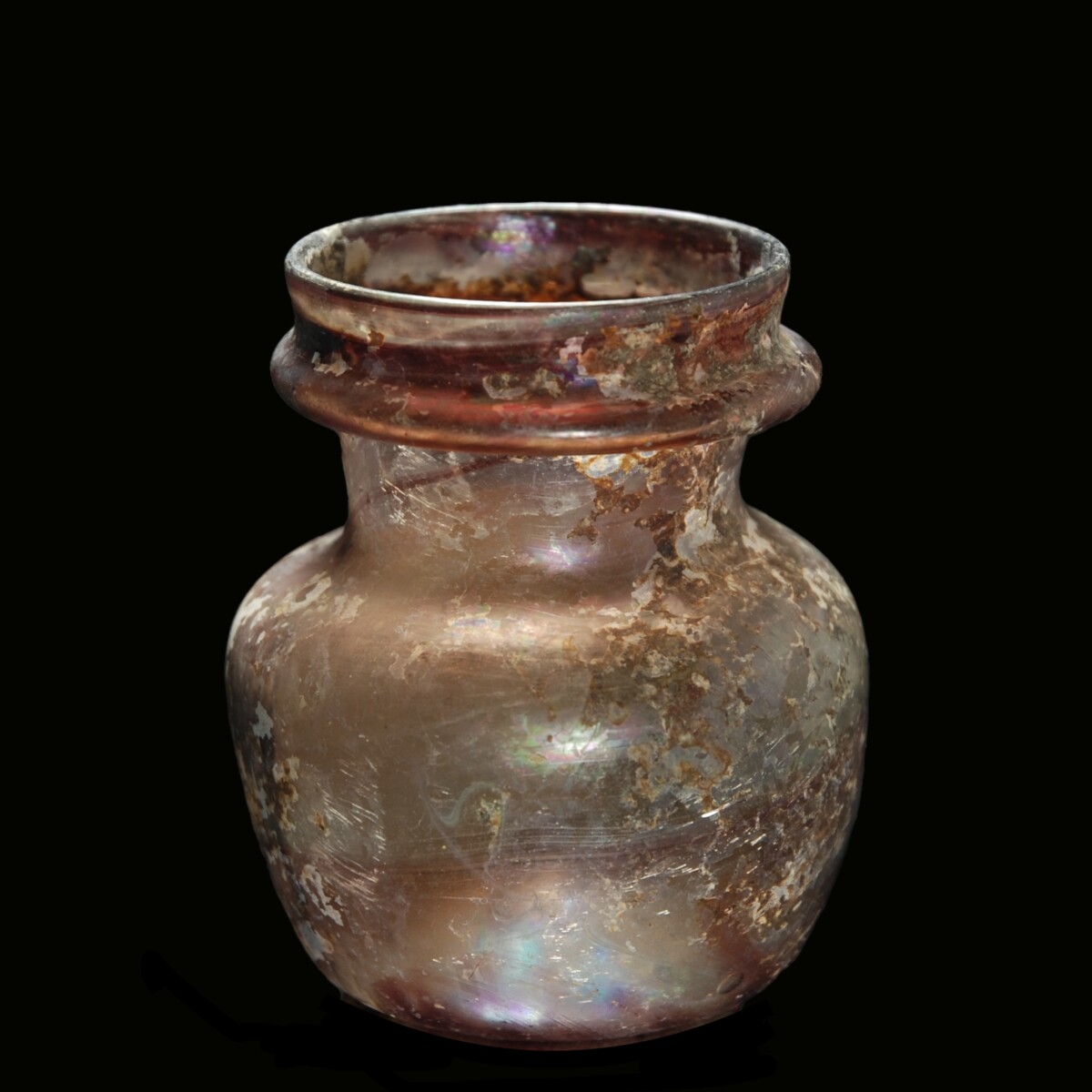
|
|
|
|
Roman Empire – Late 4th to early 5th century A.D.
|
Bulbous, free blown jar of aubergine-color clear glass with a wonderful iridescence. The base is slightly curved upwards with remains of the sharp edges what were left when the piece was knocked off the punty. The neck is short and cylindrical. The estuary is funnel-shaped, the rim is diligently rounded. Below the rim a swagged collar which opens up towards the interior of the vessel. See for the form: "Römisches, byzantinisches und frühmittelalterliches Glas – Sammlung Ernesto Wolf", Hatje Cantz 2001, number 117. From Palastine.
|
Provenance: Private collection Dr. Richard Jaffe, Jerusalem, Israel. Thence in the Israeli art market.
Dimensions: 8.8 cm high
Price: 800 Euro
|
|
|
Römisches Reich – Ende 4. bis Anfang 5. Jahrhundert n. Chr.
|
Bauchiger, freigeblasener Topf aus auberginefarbenem Klarglas mit herrlicher Irisierung. Der Boden ist leicht nach oben gewölbt mit Resten der Heftnarbe. Der Hals ist kurz und zylindrisch. Die Mündung ist trichterförmig, der Rand sorgfältig abgerundet. Unter dem Rand ein gestauchter Kragen, der zum Gefäßinneren offen ist. Vergleiche zur Form: „Römisches, byzantinisches und frühmittelalterliches Glas – Sammlung Ernesto Wolf“, Hatje Cantz 2001, Nummer 117. Aus Palästina.
|
Provenienz: Privatsammlung Dr. Richard Jaffe, Jerusalem, Israel. Danach im israelischen Kunsthandel.
Höhe: 8,8 cm
Preis: 800 Euro
|
|
|
|
Roman Glass Beakers
from the Viennese Collection Dr. Peter Rudeck
|
|
The collection of the Viennese lawyer Dr. Peter Rudeck, which we recently were able to welcome in our gallery program, consists of Greek and Cypriot ceramics, as well as over 30 Roman glasses that were acquired in Vienna from the late 1980s to around the mid-1990s. This week we are pleased to introduce to you the Roman glass beakers from this collection – all intact and for particularly attractive prices.
|
|

|
Römische Glasbecher aus der Sammlung des Wiener Rechtsanwalts Dr. Peter Rudeck
|
|
Die Sammlung des Wiener Rechtsanwalts Dr. Peter Rudeck, die wir kürzlich in unser Galerieprogramm aufnehmen konnten, umfasst neben griechischer und zypriotischer Keramik auch über 30 römische Gläser, die von Ende der 1980er bis etwa Mitte der 1990er Jahre in Wien erworben wurden. Wir freuen uns, Ihnen diese Woche zunächst die römischen Glasbecher der Sammlung vorstellen zu dürfen – alle intakt und zu besonders attraktiven Preisen.
|
|
|
|
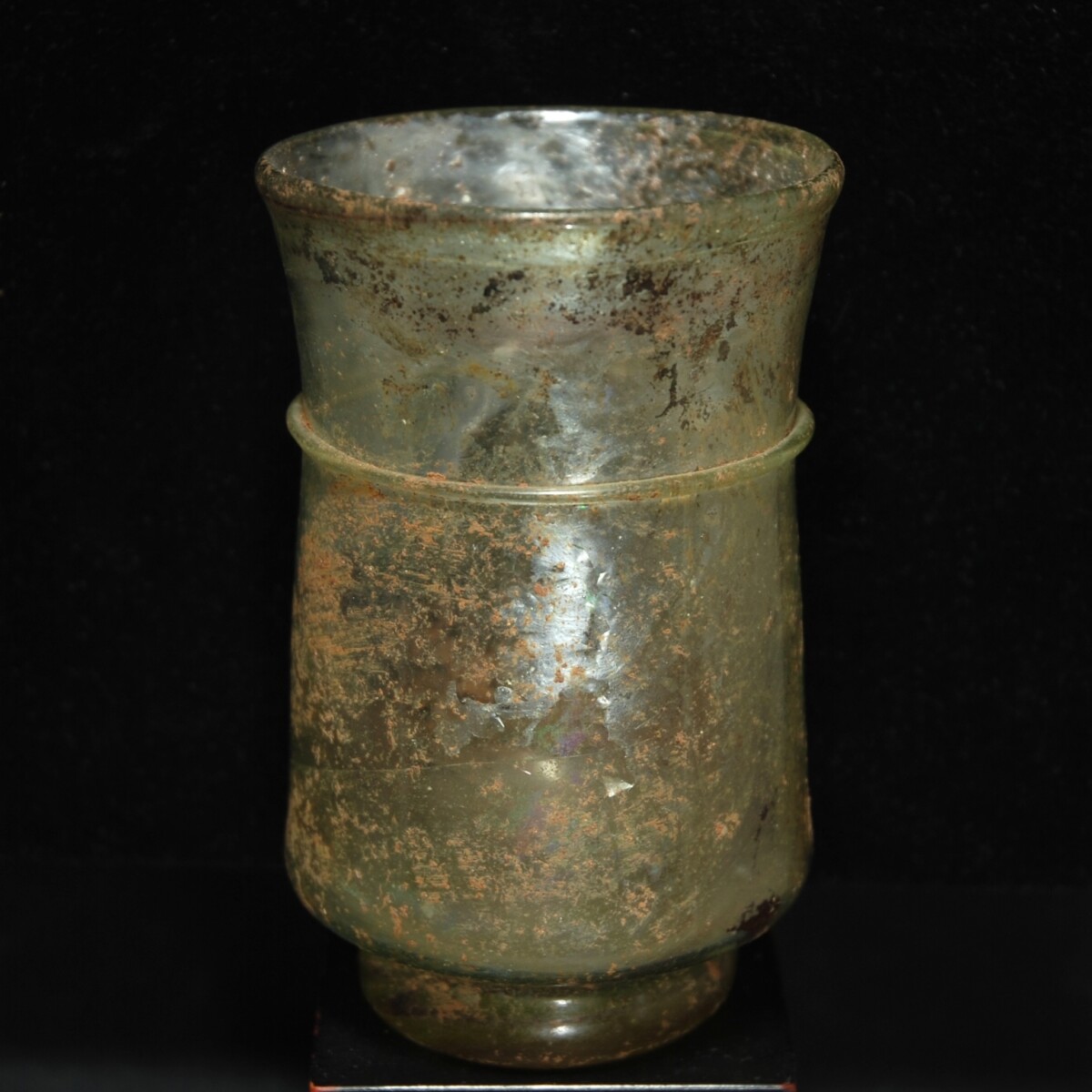
|
|
Roman Empire/Palestine – Early 4th century A.D.
|
Roman glass beaker made of transparent, almost completely discoloured glass. The body with a cylindrical, slightly concave wall. The rim is pulled outwards, rounded and thickened. The massive base was worked out from the wall and flattened. On the upper part of the beaker an encircling applied thread. With a very beautiful silvery iridescence. See for the typus “Römisches, byzantinisches und frühmittelalterliches Glas – Sammlung Ernesto Wolf”, Hatje Cantz 2001, number 108. From Palastine.
|
Provenance: Acquired on 5 June 1990 from Gerhard Herinek in Vienna. With the original certificate.
Dimensions: 10.8 cm high
Price: 1 200 Euro
|
|
|
Römisches Reich/Palästina – Anfang 4. Jahrhundert n. Chr.
|
Römischer Becher aus durchsichtigem, fast vollständig entfärbtem Glas. Der Korpus mit zylindrischer, leicht konkaver Wand. Der Rand ist nach außen gedreht und heiß verrundet und verdickt. Der massive Boden wurde aus der Wandung herausgearbeitet und abgeflacht. Im oberen Teil des Bechers ein umlaufend aufgelegter Faden. Mit sehr schöner silberner Irisierung. Vergleiche zum Typus „Römisches, byzantinisches und frühmittelalterliches Glas“ – Sammlung Ernesto Wolf“, Hatje Cantz 2001, Nummer 108. Aus Palästina.
|
Provenienz: Erworben am 5. Juni 1990 bei Gerhard Herinek in Wien. Mit Original-Zertifikat.
Höhe: 10,8 cm
Preis: 1.200 Euro
|
|
|
|
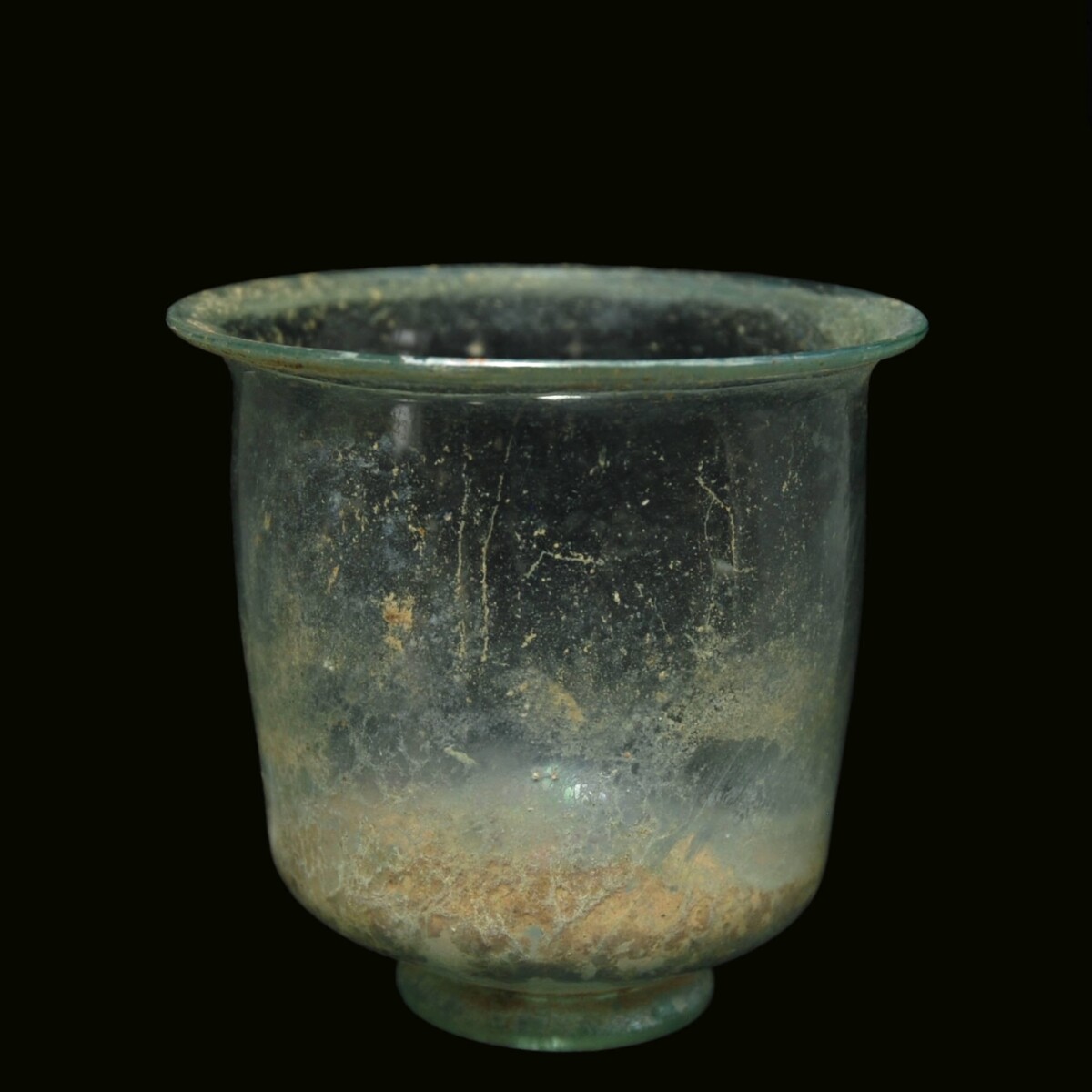
|
|
Roman Empire/North Italy – 3rd-4th century A.D.
|
Roman beaker made transparent, almost completely discoloured glass. The cylindrical body stands on a massive foot ring, worked out from the wall and rounded. On the flattened base remains of the sharp edges that were left when the piece was knocked off the punty are still preserved. The rim is far pulled outwards, rounded and thickened. Possibly from northern Italy. See for the typus: Gertrud Platz-Horster “Antike Gläser: Ausstellung, November 1976-Februar 1977, Antikenmuseum Berlin”, No. 148.
|
Provenance: Acquired on 5 June 1990 from Gerhard Herinek in Vienna. With the original certificate.
Dimensions: 8.8 cm high
Price: 600 Euro
|
|
|
Römisches Reich/Norditalien – 3.-4. Jahrhundert n. Chr.
|
Römischer Becher aus durchsichtigem, fast vollständig entfärbtem Glas. Der zylindrische Korpus steht auf einem massiven, aus der Wandung gearbeiteten und heiß abgerundeten Standfuß. Auf der abgeflachten Unterseite sind noch Reste der Heftnarbe erhalten. Der Rand ist weit nach außen gedreht, und heiß verrundet und verdickt. Wohl aus Norditalien. Vergleiche zum Typus: Gertrud Platz-Horster „Antike Gläser: Ausstellung, November 1976-Februar 1977, Antikenmuseum Berlin“, Nr. 148.
|
Provenienz: Privatsammlung Dr. Peter Rudeck, Wien. Erworben am 5. August 1990 bei Gerhard Herinek in Wien. Mit Original-Zertifikat.
Höhe: 8,8 cm
Preis: 600 Euro
|
|
|
|
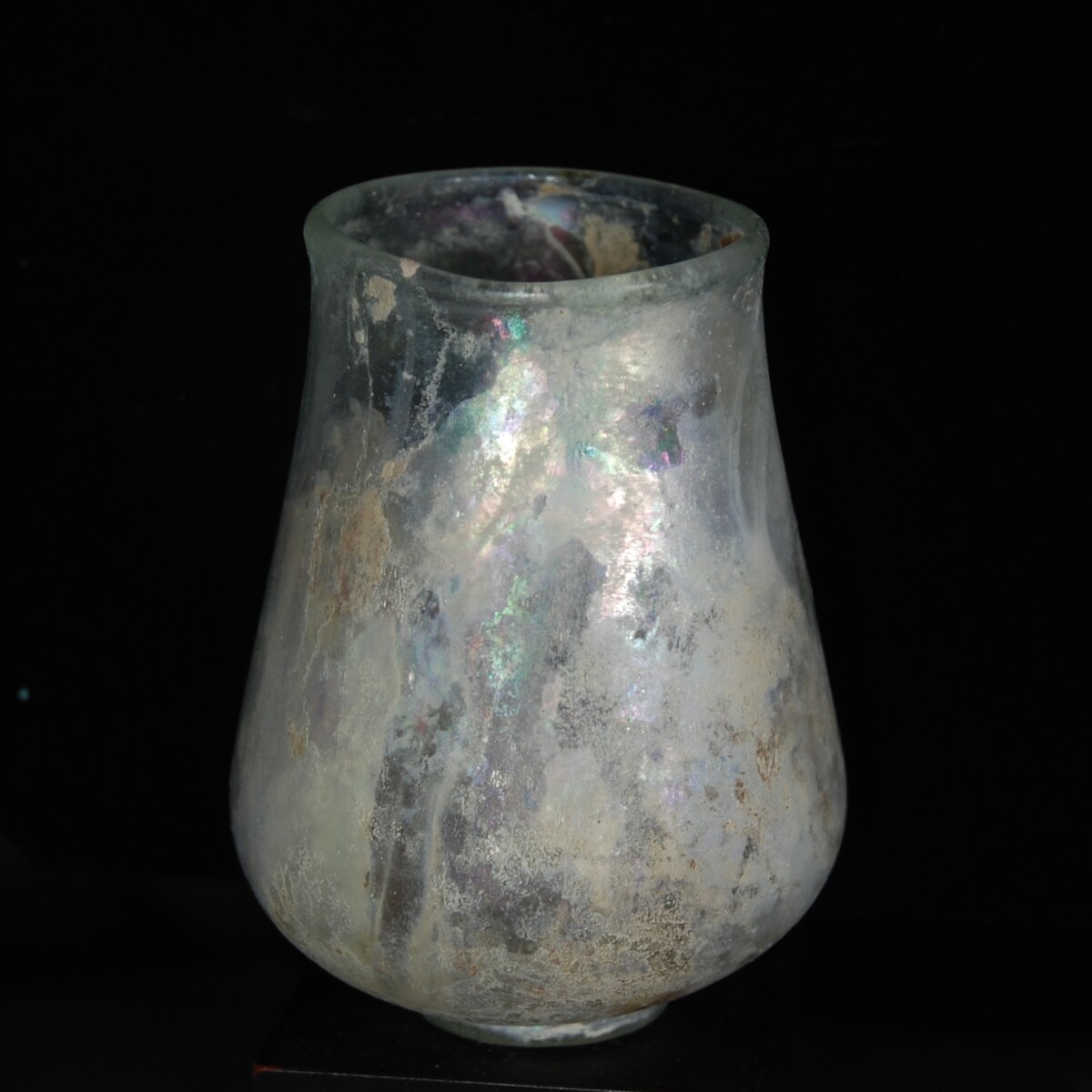
|
|
Roman Empire/Rhineland – 4th century A.D.
|
Roman glass beaker with wonderful silver iridescence standing on a ring foot, worked out from the wall and rounded on the outside. The body is far protruding on the base and tapering towards the top. The rim is slightly pulled outwards, rounded and thickened. Form the Rhineland. Similar beakers are in the Pompejanum Aschaffenburg, as well as in Cologne and Nijmegen (Netherlands).
|
Provenance: Acquired on 28 March 1989 from Gerhard Herinek in Vienna. With the original certificate.
Dimensions: 10 cm high
Price: 800 Euro
|
|
|
Römisches Reich/Rheinland – 4. Jahrhundert n. Chr.
|
Römischer Glasbecher mit herrlicher Silber-Irisierung, der auf einem aus der Wandung gearbeiteten und außen abgerundeten Standring steht. Der Korpus ist unten weit ausladend und verjüngt sich nach oben. Der Rand ist leicht nach außen gebogen und heiß verrundet und verdickt. Aus dem Rheinland. Ähnliche Becher befinden sich im Pompejanum Aschaffenburg sowie in Köln und Nijmegen (Niederlande).
|
Provenienz: Erworben am 28. März 1989 bei Gerhard Herinek in Wien. Mit Original-Zertifikat.
Höhe: 10 cm
Preis: 800 Euro
|
|
|
|
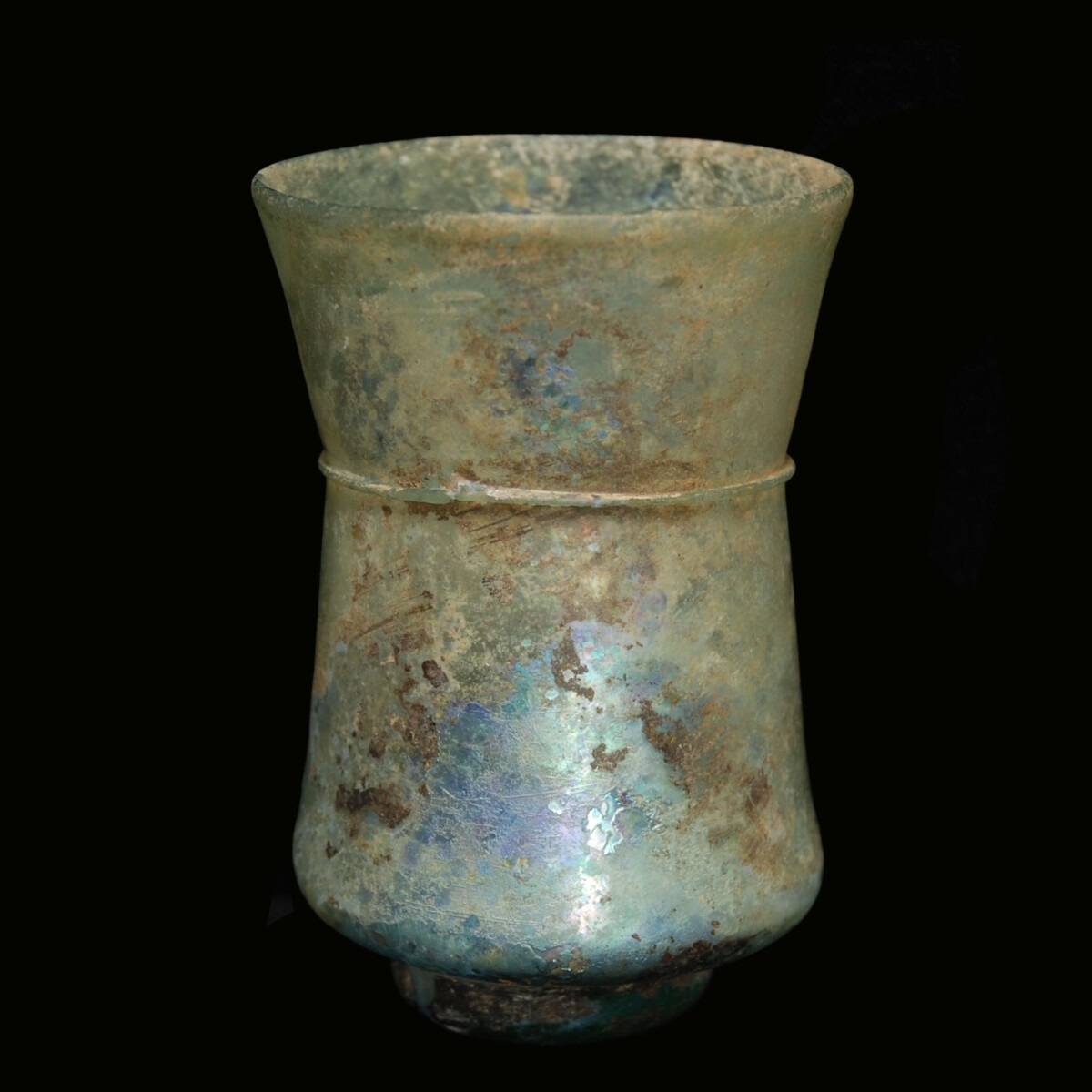
|
|
Roman Empire/Palestine – Early 4th century A.D.
|
Roman beaker made of transparent, almost completely discoloured glass. The body with a concave wall. The rim is slightly pulled outwards, rounded and thickened. The massive base with remains of the sharp edges that were left when the piece was knocked off the punty was worked out from the wall and flattened. On the narrowest part of the corpus an encircling applied thread. In some parts with very beautifully silvery iridescence. See for the typus “Römisches, byzantinisches und frühmittelalterliches Glas – Sammlung Ernesto Wolf”, Hatje Cantz 2001, number 108. From Palastine.
|
Provenance: Acquired on 7 July 1992 from Gerhard Herinek in Vienna. With the original certificate.
Dimensions: 11.5 cm high
Price: 1 200 Euro
|
|
|
Römisches Reich/Palästina – frühes 4. Jahrhundert n. Chr.
|
Römischer Becher aus durchsichtigem, fast vollständig entfärbtem Glas. Der Korpus mit konkaver Wandung. Der Rand ist leicht nach außen gedreht und heiß verrundet und verdickt. Der massive Boden mit Resten der Heftnarbe wurde aus der Wandung herausgearbeitet und abgeflacht. An der engsten Stelle des Korpus ein umlaufend aufgelegter Faden. Stellenweise mit sehr schöner silberner Irisierung. Vergleiche zum Typus „Römisches, byzantinisches und frühmittelalterliches Glas – Sammlung Ernesto Wolf“, Hatje Cantz 2001, Nummer 108. Aus Palästina.
|
Provenienz: Erworben am 7. Juli 1992 bei Gerhard Herinek in Wien. Mit Original-Zertifikat.
Höhe: 11,5 cm
Preis: 1.200 Euro
|
|
|
|
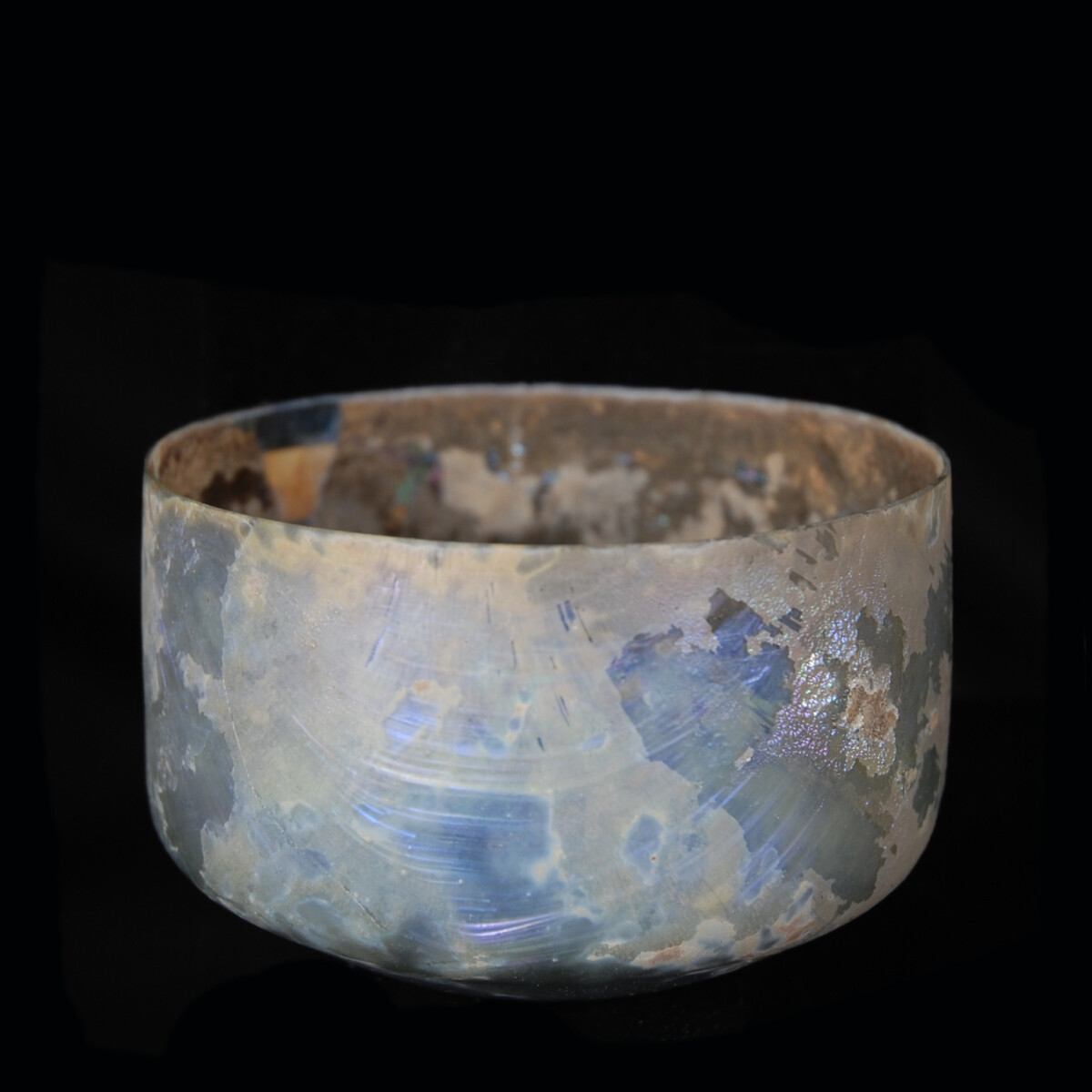
|
|
Roman Empire – 1st-2nd century A.D.
|
Large glass beaker with a straight wall and wonderfully shimmering mother of pearls patina. The rim is smoothly over-cut, the base deeply pierced from the outside, so that a tapering cone is created. With an old collection label.
|
Provenance: From the estate of the French art dealer Evrard de Rouvre (1923-1979). Thence in the possession of his daughter Isabelle and her husband Francois van den Broek. Last in a family estate.
Dimensions: 9.4 cm in diameter
Price: 400 Euro
|
|
|
Römisches Reich – 1.-2. Jahrhundert n. Chr.
|
Großer Glasbecher mit gerader Wandung und herrlicher schimmernder Perlmutt-Patina. Der Rand ist glatt geschliffen, der Boden von außen tief eingestochen, so dass im Inneren ein spitz zulaufender Kegel entsteht. Mit altem Sammlungsetikett.
|
Provenienz: Aus dem Nachlass des französischen Kunsthändlers Evrard de Rouvre (1923-1979). Danach im Besitz seiner Tochter Isabelle und ihres Mannes Francois van den Broek. Seitdem in Familienbesitz.
Durchmesser: 9,4 cm
Preis: 400 Euro
|
|
|
|
|
|
|
CHRISTOPH BACHER ARCHÄOLOGIE ANCIENT ART GmbH
|
Galerie: Stubenring 20, A-1010 Wien
Showroom: Untere Viaduktgasse 55, A-1030 Wien
|
|

|
|
|
|
